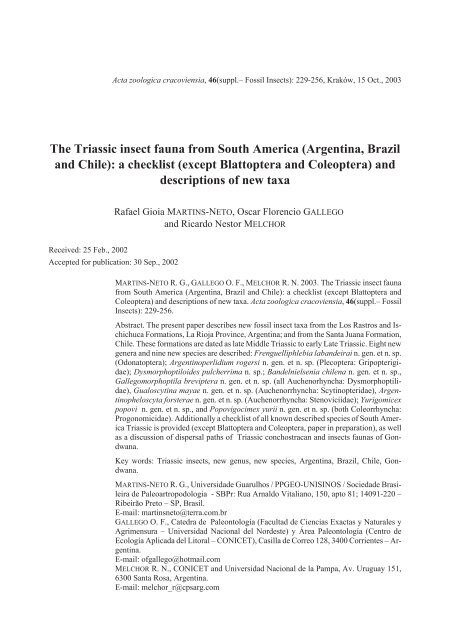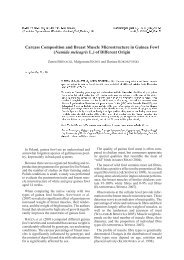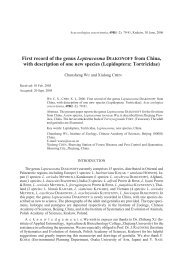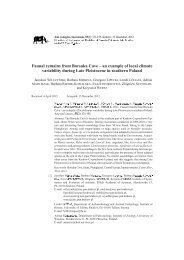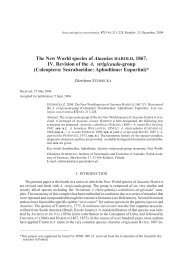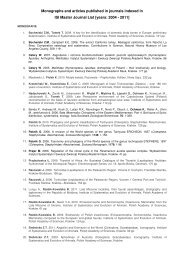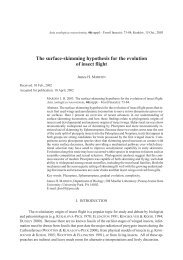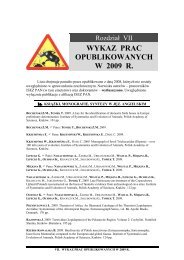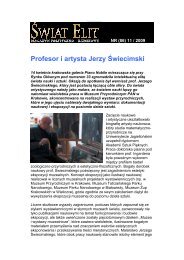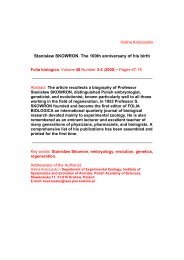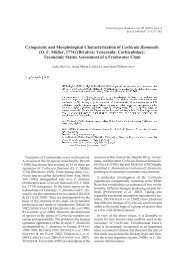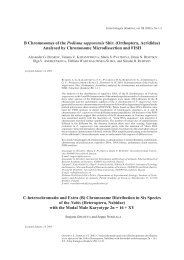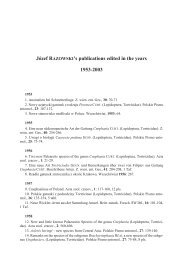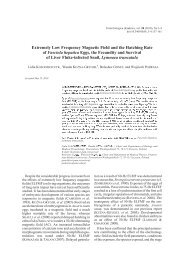Rafael Gioia MARTINS-NETO, Oscar Florencio GALLEGO
Rafael Gioia MARTINS-NETO, Oscar Florencio GALLEGO
Rafael Gioia MARTINS-NETO, Oscar Florencio GALLEGO
You also want an ePaper? Increase the reach of your titles
YUMPU automatically turns print PDFs into web optimized ePapers that Google loves.
Acta zoologica cracoviensia, 46(suppl.– Fossil Insects): 229-256, Kraków, 15 Oct., 2003<br />
The Triassic insect fauna from South America (Argentina, Brazil<br />
and Chile): a checklist (except Blattoptera and Coleoptera) and<br />
descriptions of new taxa<br />
<strong>Rafael</strong> <strong>Gioia</strong> <strong>MARTINS</strong>-<strong>NETO</strong>, <strong>Oscar</strong> <strong>Florencio</strong> <strong>GALLEGO</strong><br />
and Ricardo Nestor MELCHOR<br />
Received: 25 Feb., 2002<br />
Accepted for publication: 30 Sep., 2002<br />
<strong>MARTINS</strong>-<strong>NETO</strong> R. G., <strong>GALLEGO</strong> O. F., MELCHOR R. N. 2003. The Triassic insect fauna<br />
from South America (Argentina, Brazil and Chile): a checklist (except Blattoptera and<br />
Coleoptera) and descriptions of new taxa. Acta zoologica cracoviensia, 46(suppl.– Fossil<br />
Insects): 229-256.<br />
Abstract. The present paper describes new fossil insect taxa from the Los Rastros and Ischichuca<br />
Formations, La Rioja Province, Argentina; and from the Santa Juana Formation,<br />
Chile. These formations are dated as late Middle Triassic to early Late Triassic. Eight new<br />
genera and nine new species are described: Frenguelliphlebia labandeirai n. gen. et n. sp.<br />
(Odonatoptera); Argentinoperlidium rogersi n. gen. et n. sp. (Plecoptera: Gripopterigidae);<br />
Dysmorphoptiloides pulcherrima n. sp.; Bandelnielsenia chilena n. gen. et n. sp.,<br />
Gallegomorphoptila breviptera n. gen. et n. sp. (all Auchenorhyncha: Dysmorphoptilidae),<br />
Gualoscytina mayae n. gen. et n. sp. (Auchenorrhyncha: Scytinopteridae), Argentinopheloscyta<br />
forsterae n. gen. et n. sp. (Auchenorrhyncha: Stenoviciidae); Yurigomicex<br />
popovi n. gen. et n. sp., and Popovigocimex yurii n. gen. et n. sp. (both Coleorrhyncha:<br />
Progonomicidae). Additionally a checklist of all known described species of South America<br />
Triassic is provided (except Blattoptera and Coleoptera, paper in preparation), as well<br />
as a discussion of dispersal paths of Triassic conchostracan and insects faunas of Gondwana.<br />
Key words: Triassic insects, new genus, new species, Argentina, Brazil, Chile, Gondwana.<br />
<strong>MARTINS</strong>-<strong>NETO</strong> R. G., Universidade Guarulhos / PPGEO-UNISINOS / Sociedade Brasileira<br />
de Paleoartropodologia - SBPr: Rua Arnaldo Vitaliano, 150, apto 81; 14091-220 –<br />
Ribeirão Preto – SP, Brasil.<br />
E-mail: martinsneto@terra.com.br<br />
<strong>GALLEGO</strong> O. F., Catedra de Paleontología (Facultad de Ciencias Exactas y Naturales y<br />
Agrimensura – Universidad Nacional del Nordeste) y Área Paleontología (Centro de<br />
Ecología Aplicada del Litoral – CONICET), Casilla de Correo 128, 3400 Corrientes – Argentina.<br />
E-mail: ofgallego@hotmail.com<br />
MELCHOR R. N., CONICET and Universidad Nacional de la Pampa, Av. Uruguay 151,<br />
6300 Santa Rosa, Argentina.<br />
E-mail: melchor_r@cpsarg.com
230<br />
R. G. <strong>MARTINS</strong>-<strong>NETO</strong> et al.<br />
I. INTRODUCTION<br />
This paper presents new data about the fossil record of Triassic insects from Argentina, Brazil<br />
and Chile, and a compendium of reported occurrences. The Triassic insect faunas from South<br />
America are sparse and poorly known<br />
from this time. Only six Triassic insects<br />
localities are presently known: Mendoza (Cacheuta hill), La Rioja (Gualo River and “Quebrada de<br />
Ischichuca Chica”) Provinces (western Argentina), São Paulo (Timbó river), Rio Grande do Sul<br />
(Passo das Tropas) states (Brazil), and Concepción (southern Chile).<br />
Previous records of these faunas were summarized by <strong>GALLEGO</strong> (1997), <strong>GALLEGO</strong> &MAR-<br />
TINS-<strong>NETO</strong> (1999) and <strong>MARTINS</strong>-<strong>NETO</strong> &<strong>GALLEGO</strong> (1999). The presence of fossil insects in Triassic<br />
sediments of South America was first reported by WIELAND (1925); this record has been significantly<br />
expanded by subsequent authors.<br />
Argentinian faunas are the richest in South America, with the most described species in an extensive<br />
literature. Only three species have been described from Brazil; Chilean occurrences have<br />
been mentioned only as undetermined insects (FUENZALIDA 1937; CECIONI &WESTERMANN 1968)<br />
from localities Punta Puquén, Los Lobos and Los Molles in Central Chile.<br />
In the present paper we describe new taxa from Argentina, the described species from Argentina<br />
and Brazil are listed, and new specimens from Chile are reported for the first time (Concepción locality,<br />
southern Chile).<br />
This paper contains the first overview of the Triassic insect fauna of Argentina (excluding Coleoptera<br />
and Blattoptera), including many recent findings. Coleoptera and Blattoptera (which include<br />
a total of about 1355 specimens) will be treated by us elsewhere. The material described herein includes<br />
23 genera and 28 species (33 specimens, Table I) from Cuyo and Ischigualasto – Villa Unión<br />
Basins of Argentina (Fig. 1) (most specimens) and from the Paraná basin of Brazil (two specimens).<br />
Terminology and classification adopted here conforms mainly to that of KUKALOVÁ-PECK<br />
(1991) and VILESOV &NOVOKSHONOV (1994).<br />
Abbreviations:<br />
CORD-PZ – Palaeozoological Collection, Universidad Nacional de Cordoba, Argentina<br />
MACN – Museo Argentino de Ciencias Naturales, Buenos Aires, Argentina<br />
MLP – Museo de La Plata (Invertebrate Paleontology), Argentina<br />
MMHN – Museo Municipal de Historia Natural de San <strong>Rafael</strong>, Mendoza, Argentina<br />
PULR-I – Invertebrate Paleontological Collection, Universidad Nacional de La Rioja, Argentina<br />
PZ-CTES – Paleozoological Collection of the Facultad de Ciencias Exactas, Naturales<br />
y Agrimensura de la Universidad Nacional del Nordeste, Mendoza, Argentina.<br />
SGO-PI – Paleontology Section of the Museo Nacional de Historia Natural, Santiago, Chile.<br />
USP – Universidade de São Paulo, campus de Ribeirão Preto, SP, Brazil.<br />
Acknowledgements.Wethank Dr. Ana Maria ZAVATTIERI (Ianigla-Cricyt-<br />
CONICET, Mendoza, Argentina), Dr. Augusto MENÉNDEZ, Lic. Jorge CRUZ and Sr. Alberto<br />
ACOSTA for field assistance and collaboration in the Mendoza Province Triassic outcrops. We also<br />
acknowledge Lic. Andrea ARCUCCI (Universidad Nacional de San Luís, Argentina), Drs. Catherine<br />
FORSTER, Cathleen MAY and Raymond ROGERS from the project “El contexto del origen de los Dinosaurios:<br />
Paleontología y Paleoecología de la Formación Los Rastros, Triásico Medio de La<br />
Rioja”, National Geographic Society (Grant 5317-94). Special thanks to Dr. Klaus BANDEL and<br />
Geol. Sven NIELSEN (Universität Hamburg, Geologisch-Paläontologisches Institut and Museum)<br />
for providing us with material collected in the Chilean Triassic. Thanks are also due to our special<br />
friend, Dr. Yuri POPOV (Russian Academy of Sciences), for his help in the description of the Heteroptera<br />
specimen, and to our “computer magician”, Vinicius Moreno DE GODOI (FFCLRP/SBPr),<br />
for help in all of the informatics problems and solutions.
Triassic insect fauna from South America<br />
Table I<br />
231<br />
Summary of the insect taxa described in this paper, grouped by unit and locality<br />
Order Family Species<br />
Potrerillos Formation (Cerro Cacheuta, Mendoza, Cuyo basin)<br />
Odonatoptera Incertae sedis Triassothemis mendozensis CARPENTER 1960<br />
Odonatoptera Incertae sedis Frenguelliphlebia labandeirai <strong>MARTINS</strong>-<strong>NETO</strong> &<strong>GALLEGO</strong> n. sp.<br />
Plecoptera Gripopterygidae: Euxenoperlinae Gondwanoperlidium argentinarum PINTO &PURPER 1978<br />
Gondwanoperlidium mendozensis PINTO &PURPER 1978<br />
Miomoptera Incertae sedis Miomina mendozina <strong>MARTINS</strong>-<strong>NETO</strong> &<strong>GALLEGO</strong> 1999<br />
Grylloblattida Atactophlebiidae Triasseuryptilon acostai (MARQUAT) STOROZHENKO 1997<br />
Ensifera Haglidae Notopamphagopsis bolivari CABRERA 1928<br />
Auchenorrhyncha Dysmorphoptilidae Dysmorphoptiloides acostai <strong>MARTINS</strong>-<strong>NETO</strong> &<strong>GALLEGO</strong> 1999 (*)<br />
Auchenorrhyncha Chiliocyclidae Tipuloidea rhaetica WIELAND 1925<br />
Argentinocicada magna <strong>MARTINS</strong>-<strong>NETO</strong> &<strong>GALLEGO</strong> 1999<br />
Argentinocicada minima <strong>MARTINS</strong>-<strong>NETO</strong> &<strong>GALLEGO</strong> 1999<br />
Auchenorrhyncha Scytinopteridae Potrerillia nervosa <strong>MARTINS</strong>-<strong>NETO</strong> &<strong>GALLEGO</strong> 1999<br />
Trichoptera? / Tipulidites affinis WIELAND 1926<br />
Diptera? Necrotaulius affinis WIELAND 1926<br />
Los Rastros Formation (Río Gualo, La Rioja, Ischigualasto – Villa Unión basin)<br />
Glosselytrodea Polycytellidae Argentinoglosselytrina pulchella <strong>MARTINS</strong>-<strong>NETO</strong> &<strong>GALLEGO</strong> 2000 (*)<br />
Plecoptera Gripopterygidae: Euxenoperlinae Argentinoperlidium rogersi <strong>MARTINS</strong>-<strong>NETO</strong> &<strong>GALLEGO</strong> n. sp<br />
Ensifera Haglidae Notopamphagopsis? sp. 1<br />
Notopamphagopsis? sp. 2<br />
Notopamphagopsis? sp. 3<br />
Auchenorrhyncha Dysmorphoptilidae Dysmorphoptiloides acostai <strong>MARTINS</strong>-<strong>NETO</strong> &<strong>GALLEGO</strong> 1999 (*)<br />
Dys morphoptiloides gigantea <strong>MARTINS</strong>-<strong>NETO</strong> &<strong>GALLEGO</strong> 2000<br />
Dysmorphoptiloides pulcherrima <strong>MARTINS</strong>-<strong>NETO</strong> &<strong>GALLEGO</strong> n. sp.<br />
Gallegomorphoptila breviptera <strong>MARTINS</strong>-<strong>NETO</strong> n. sp.<br />
Auchenorrhyncha Scytinopteridae Australocicada arcucciae <strong>MARTINS</strong>-<strong>NETO</strong> &<strong>GALLEGO</strong> 2000 (*)<br />
Gualoscytina mayae <strong>MARTINS</strong>-<strong>NETO</strong> &<strong>GALLEGO</strong> n. sp<br />
Auchenorrhyncha Stenoviciidae<br />
Argentinopheloscyta forsterae <strong>MARTINS</strong>-<strong>NETO</strong> &<strong>GALLEGO</strong> n. sp<br />
Coleorrhyncha Progonomicidae Yurigocimex popovi <strong>MARTINS</strong>-<strong>NETO</strong> &<strong>GALLEGO</strong> n. sp.<br />
Popovigocimex yurii <strong>MARTINS</strong>-<strong>NETO</strong> &<strong>GALLEGO</strong> n. sp.<br />
Ischichuca Formation (Quebrada Ischichuca, La Rioja, Ischigualasto – Villa Unión basin)<br />
Auchenorrhyncha Prosboloidea: Prosbolidae (2) Lariojaprosbole melchori <strong>MARTINS</strong>-<strong>NETO</strong> &<strong>GALLEGO</strong> 2000 (*)<br />
Rio Do Rastro Formation (near Poço Preto, Santa Catarina, Paraná basin)<br />
Auchenorrhyncha Prosboloidea: Prosbolidae Prosbolidinella riorastensis <strong>MARTINS</strong>-<strong>NETO</strong> &ROHN 1996<br />
Santa María Formation (Passo das Tropas, Rio Grande do Sul, Paraná basin)<br />
Trichoptera?<br />
Sanctipaulus mendesi PINTO1956<br />
(*) Indicates two specimens. The remaining occurrences are known from a single specimen.
232<br />
R. G. <strong>MARTINS</strong>-<strong>NETO</strong> et al.<br />
Fig. 1. Map showing the Cuyo and Ischigualasto – Villa Unión basins and the locations of the three insect-bearing localities<br />
mentioned in the text.<br />
II. GEOLOGICAL ASPECTS<br />
Most of the known Triassic insect fauna from Argentina come from the Potrerillos and Los<br />
Rastros Formations, which belong to Cuyo and Ischigualasto Villa-Unión rift basins respectively<br />
(Fig. 1). Each of these units have yielded a single insect-bearing locality or area: Cerro Cacheuta, of<br />
the Potrerillos Formation (northern Mendoza Province) and the Río Gualo area of the Los Rastros<br />
Formation (Talampaya Park, southern La Rioja Province). The Potrerillos Formation is included in<br />
the Uspallata Group and represents the depositional record of the second sinrift phase of KOKOGIÁN<br />
et al. (1993). Occurrences of insect remains at Cerro Cacheuta were concentrated in a 3 km-long<br />
tract along the strike of the upper part of the Potrerillos Formation in the southern flank of the hill<br />
(approximately 33º 05’ S, 69º 07’ W; see MOREL 1994: Fig. 1). The stratigraphic interval where<br />
most insect remains were collected has been interpreted as floodplain, crevasse, and levee facies<br />
(MOREL 1994; KOKOGIÁN et al. 1999) in an intermediate to high sinuosity fluvial system (KOKO-<br />
GIÁN et al. 1999; BELLOSI et al., in press). At Cerro Cacheuta, these facies grade to distributary sys-
Triassic insect fauna from South America<br />
233<br />
tems (mouth bar, channel, and interdistributary bay) of lacustrine deltas (KOKOGIÁN et al. 1999).<br />
Associated plant remains have been attributed to the BNP biozone of SPALLETTI et al. (1999).<br />
Both the Los Rastros and Ischichuca Formations belong to the Agua de la Peña Group of the Ischigualasto<br />
– Villa Unión Basin. The insect fauna from the Los Rastros Formation was recovered<br />
from Río Gualo (about 29° 53’ S; 67° 46’ W), southern La Rioja Province, Talampaya Park (Fig. 1).<br />
In this area the exposures of the Los Rastros Formation are mostly composed of deep-lacustrine<br />
mudstones, storm and wave-influenced delta-front siltstones, and channel sandstones. Insect remains<br />
are preferentially preserved in olive-green, thinly laminated mudstones deposited in deep,<br />
well-oxygenated lakes.<br />
Ischichuca Formation is dominantly composed of shallow and deep lacustrine facies with progadational<br />
deltaic successions (MELCHOR 1998). In particular, insect remains come from dark<br />
brown to olive-green claystones with abundant plant remains from the lower part of the unit. This<br />
interval is interpreted as a shallow, partially saline lake. The Ischichuca Formation continental palynologic<br />
assemblage is closely comparable to those of the Ipswich Microflora of Australia (ZAVAT-<br />
TIERI &MELCHOR 1999). The Macroflora of this unit was included by SPALLETTI et al. (1999) in<br />
the CSD biozone.<br />
There is general agreement that the age of the Potrerillos Formation is late Middle Triassic to<br />
early Late Triassic (e.g., STIPANICIC 1983; MOREL 1994; ZAVATTIERI &BATTEN 1996; SPAL-<br />
LETTI et al. 1999; KOKOGIÁN et al. 1999). In contrast, disagreement exists on the age of the Ischichuca<br />
and Los Rastros Formations (mainly concerning the former). Most authors consider these<br />
units to be of approximately the same age as the Potrerillos Formation (STIPANICIC &BONAPARTE<br />
1979; STIPANICIC 1983; KOKOGIÁN et al., 1999). However, in the recent chronostratigraphic<br />
scheme of SPALLETTI et al. (1999) both the Ischichuca and Los Rastros Formations are restricted to<br />
the lower part of the Middle Triassic. Conversely, ZAVATTIERI &MELCHOR (1999) suggest that the<br />
age of the Ischichuca Formation, on the basis of its palynological content, is late Ladinian-nearly<br />
Carnian. This is in agreement with a previous palynological assessment of Carnian age for the overlying<br />
Los Rastros Formation (ZAVATTIERI &BATTEN 1996).<br />
The remaining occurrences of Triassic insects discussed in this paper (Table I) come from the<br />
Paraná basin in southeast Brazil, from Rio do Rasto, and from the Santa Maria Formation. The Rio<br />
do Rasto Formation (uppermost unit of the Passa Dois Group) have been considered of Late Permian<br />
age until recent findings of <strong>MARTINS</strong>-<strong>NETO</strong> &ROHN (1996), who suggest a maximum Early<br />
Triassic age for this unit based on its flora, Conchostracan fauna, and insect remains (Prosbolidinella<br />
riorastensis <strong>MARTINS</strong>-<strong>NETO</strong> &ROHN 1996). This formation is considered essentially of fluvial<br />
origin. The overlying Santa Maria Formation (Rosario do Sul Group) is a continental red-bed<br />
sequence from the central region of Rio Grande do Sul. Typical facies include mudstones intercalated<br />
with fine-grained sandstones, deposited in the floodplains of a braided fluvial system (HOLZ &<br />
BARBERENA 1994). The Santa Maria Formation is well known for its high diversity of fossil tetrapods<br />
(e.g., BONAPARTE 1982), which allowed its assignment to the Late Triassic (e.g., ANDERSON<br />
&ANDERSON 1993; BENTON 1983), specifically the Carnian (SHUBIN &SUES 1991). Its fauna is<br />
similar to that of the Ischigualasto Formation of the Ischigualasto – Villa Unión basin of Argentina,<br />
which may imply a slightly younger age than the Ischichuca and Los Rastros Formations.<br />
III. SYSTEMATIC PALEONTOLOGY<br />
ODONATOPTERA<br />
Family incertae sedis<br />
Triassothemis mendozensis CARPENTER, 1960<br />
Fig. 2G-H<br />
*1960 Triassothemis mendozensis CARPENTER: 71-73, Fig. 1
234<br />
R. G. <strong>MARTINS</strong>-<strong>NETO</strong> et al.<br />
1992 Triassothemis mendozensis CARPENTER: 78; 1997 Triassothemis mendozensis CARPENTER in GAL-<br />
LEGO: 512-513; 1999 Triassothemis mendozensis CARPENTER in <strong>GALLEGO</strong> &<strong>MARTINS</strong>-<strong>NETO</strong>: 87-88, Fig. 16.<br />
Holotype.MACN no. 18040, housed in MACN, Argentina. Type locality: Aguas de<br />
las Avispas, Cerro Cacheuta, Argentina. Type stratum : Potrerillos Formation. Age: late Middle Triassic<br />
to early Late Triassic.<br />
Frenguelliphlebia <strong>MARTINS</strong>-<strong>NETO</strong> &<strong>GALLEGO</strong>, n. gen.<br />
Diagnosis.Wing similar to Petrotypus ZALESSKY, 1950 in the general aspect of the<br />
venation, but with M and Cu moderately wavy.<br />
Type species. Frenguelliphlebia labandeirai <strong>MARTINS</strong>-<strong>NETO</strong> &<strong>GALLEGO</strong> n. sp., designated<br />
here.<br />
Etymology.Inhonor of Dr. Joaquin FRENGUELLI, the paleobotanist who first mentioned<br />
the insect fossils of this region, and phlebia, a common odonate suffix. Gender: feminine.<br />
Discussion. Frenguelliphlebia n. gen. is similar to Petrotypus ZALESSKY, 1950<br />
(Meganeuridae), from the Upper Permian of the Urals by having CuA and CuP multi-branched, differing<br />
however, by having M and Cu moderately wavy (notably wavy in Petrotypus). In this aspect<br />
Frenguelliphlebia n. gen. is similar to Triadotypus GRAUVOGEL &LAURENTIAUX, 1952 (Triadotypidae)<br />
from the Lower Triassic of France, differing, however, by having a wider cubital area and<br />
long and curved branches of Cu. The Meganeuridae as well as Triadotypidae are mostly consisting<br />
of giant species ( 90 mm in length), unlike this specimen, which is not more than 25 mm long. Additionally,<br />
Frenguelliphlebia n. gen. exhibits a combination of characters present separately in Meganeuridae<br />
and Triadotypidae. Because of this, correct family placement is uncertain, and<br />
Frenguelliphlebia n. gen. may belong to a new family. More complete material is necessary to confidently<br />
determine the family placement of this genus.<br />
Frenguelliphlebia labandeirai <strong>MARTINS</strong>-<strong>NETO</strong> &<strong>GALLEGO</strong>, n. sp.<br />
Fig. 2 I<br />
Diagnosis.Asforthegenus.<br />
Etymology.Inhonor of Dr. Conrad Christopher LABANDEIRA (Smithsonian Institution),<br />
in recognition of his great contribution to the paleoentomology.<br />
Holotype. PULR-I nº 269, housed in PULR-I, Argentina. Type locality: Gualo, La<br />
Rioja Province, Argentina. Type stratum: Los Rastros Formation. Age: late Middle Triassic to early<br />
Late Triassic.<br />
Description(Fig. 2I). Basal fragment of incomplete fore wing, 12 mm in length<br />
preserved. R+MA and Cu moderately wavy. Cu origin close to the wing base. CuA with at least five<br />
secondary branches with intercalary veins; CuP single, distally branched. Anal branches long and<br />
curved.<br />
GLOSSELYTRODEA<br />
Family: Polycytellidae MARTYNOVA, 1952<br />
Argentinoglosselytrina pulchella <strong>MARTINS</strong>-<strong>NETO</strong> &<strong>GALLEGO</strong> 2001<br />
Fig. 2A, B<br />
*2001 Argentinoglosselytrina pulchella <strong>MARTINS</strong>-<strong>NETO</strong> &<strong>GALLEGO</strong>.<br />
Holotype. PULR-I nº 253, housed in PULR-I, Argentina. Type locality: Gualo, La<br />
Rioja Province, Argentina. Type stratum: Los Rastros Formation. Age: late Middle Triassic to early<br />
Late Triassic.
Triassic insect fauna from South America<br />
235<br />
Fig. 2.A–B:Argentinoglosselytrina pulchella <strong>MARTINS</strong>-<strong>NETO</strong> &<strong>GALLEGO</strong> 2001 (Odonatoptera: Policytellidae), holotype<br />
PULR-I n° 253 (A); Argentinoglosselytrina pulchella <strong>MARTINS</strong>-<strong>NETO</strong> &<strong>GALLEGO</strong>, 2001, specimen PULR-I n° 263 (B);<br />
C. Tryasseuryptilon acostai (MARQUAT) STOROZHENKO 1997 (Grylloblattida: Atactophlebiidae), holotype MMNH n°<br />
1518, reproduced from STOROZHENKO (1997: Fig. 1); D. Necrotaulius affinis WIELAND 1925 (Mecoptera?), holotype,<br />
redrawn from WIELAND (1925: Fig. 1); E. Argentinoperlidium rogersi n. sp. (Plecoptera: Gripopterigidae), holotype<br />
PULR-I, n° 258; F. Miomima mendozina <strong>MARTINS</strong>-<strong>NETO</strong> &<strong>GALLEGO</strong> 1999 (Miomoptera, fam. inc. sed.), holotype<br />
PZ-CTES n° 5731; G-H: Triassothemis mendozensis CARPENTER 1960 (Odonatoptera, fam. inc. sed.), holotype MACN<br />
n°18040; I. Frenguelliphlebia labanderai <strong>MARTINS</strong>-<strong>NETO</strong> &<strong>GALLEGO</strong> n. sp. (Odonatoptera, fam. inc. sed.), holotype<br />
PULR-I, n° 269; J. Gondwanoperlidium argentinarum PINTO &PURPER 1978 (Plecoptera: Gripopterigidae), holotype<br />
MLP n° 8908; K. Gondwanoperlidium mendozensis PINTO &PURPER 1978, holotype CORD-PZ n° 336. Scale bar<br />
1 mm. All drawings are original, if not otherwise stated.
236<br />
R. G. <strong>MARTINS</strong>-<strong>NETO</strong> et al.<br />
Supplementary material. (Fig. 2B); PULR-I nº 263. Same age, locality, stratum and destination<br />
as in Holotype.<br />
PLECOPTERA<br />
Family: Gripopterigidae sensu RIEK, 1976<br />
Subfamily: Euxenoperlinae RIEK, 1976<br />
Gondwanoperlidium argentinarum PINTO &PURPER, 1978<br />
Fig. 2J<br />
1921 Baiera argentinii KURTZ: Pl. 21, Fig. 336<br />
1926 Elcana? argentina COCKERELL in: WIELAND: 131.<br />
1927 ?Elcana sp. COCKERELL<br />
1939 Elcana? argentina HANDLIRSCH<br />
1941 Locustopsis? argentina ZEUNER<br />
*1978 Gondwanoperlidium argentinarum, PINTO &PURPER: 79-80, Pl. 1A, Fig. 1C.<br />
1992 Gondwanoperlidium argentinarum PINTO &PURPER in CARPENTER: 97; 1997 Gondwanoperlidium<br />
argentinarum PINTO &PURPER, <strong>GALLEGO</strong>: 512-513; 1999 Gondwanoperlidium argentinarum PINTO &<br />
PURPER in <strong>GALLEGO</strong> &<strong>MARTINS</strong>-<strong>NETO</strong>: 87-88<br />
Holotype. MLPnº8908, housed in MLP, Argentina. Type locality: “Minas de Petróleo”,<br />
at Cacheuta, 14 km W of Mendoza city, Mendoza Province, Argentina. Type stratum:<br />
Potrerillos Formation. Age: late Middle Triassic to early Late Triassic.<br />
Gondwanoperlidium mendozensis PINTO &PURPER 1978<br />
Fig. 2K<br />
*1978. Gondwanoperlidium mendozensis PINTO &PURPER: 81, Pl. 1B, Fig. 1D.<br />
1995 Gondwanoperlidium mendozensis PINTO &PURPER in MAZZONI: 229, 230, Lám XXII, Fig. 22;<br />
Fig-text. 45; 1997 Gondwanoperlidium mendozensis PINTO &PURPER in <strong>GALLEGO</strong>: 512-513; 1999 Gondwanoperlidium<br />
mendozensis PINTO &PURPER in <strong>GALLEGO</strong> &<strong>MARTINS</strong>-<strong>NETO</strong>: 87-88, Fig. 17.<br />
Holotype. CORD-PZ nº 336, housed in CORD-PZ, Argentina. Type locality: “Minas<br />
de Petróleo”, at Cacheuta, 14 km W of Mendoza city, Mendoza Province, Argentina. Type stratum:<br />
Potrerillos Formation (Cacheuta Fm., sensu MAZZONI, 1995). Age: late Middle Triassic to early<br />
Late Triassic.<br />
Argentinoperlidium <strong>MARTINS</strong>-<strong>NETO</strong> &<strong>GALLEGO</strong>, n. gen.<br />
Diagnosis. Wing similar to Euxenoperla RIEK, 1976 in general aspect of venation,<br />
but ScP fused distally with RA, and M strongly curved.<br />
Type species. Argentinoperlidium rogersi <strong>MARTINS</strong>-<strong>NETO</strong> &<strong>GALLEGO</strong> n. sp., designated here.<br />
Etymology.Argentina, from which the material originates, and perlidium, from Perlida.<br />
Gender: neutrum.<br />
Discussion.Argentinoperlidium n. gen. differs of all known Euxenoperlinae by having<br />
ScP distally fused with RA (connected by a cross-vein in Euxenoperla RIEK, 1976 as well as in<br />
Gondwanoperlidium PINTO &PURPER, 1978), and M strongly curved. Additionally, Argentinoperlidium<br />
n. gen. has a more complex cross-veins pattern.
Triassic insect fauna from South America<br />
237<br />
Argentinoperlidium rogersi <strong>MARTINS</strong>-<strong>NETO</strong> &<strong>GALLEGO</strong>, n. sp.<br />
Fig. 2E<br />
Diagnosis.Asforthegenus.<br />
Etymology.Inhonor of Dr. Raymond ROGERS (Department of Geology, McAlester<br />
College, St. Paul, Minnesota), who collaborated in fieldwork, working in the collections, and did<br />
sedimentological analysis at the Gualo river site (La Rioja) for the NGS project (grant 5317-94).<br />
Holotype. nº258, housed in PULR-I. Type locality: Picos Gemelos, Gualo, La Rioja,<br />
Argentina. Type stratum: Los Rastros Formation. Age: late Middle Triassic to early Late Triassic.<br />
Description.Fore wing fragment 5 mm in length. Costal area very narrow where<br />
preserved, filled with pectinate cross-veins. ScP relatively long, distally fused with RA. RA sigmoid.<br />
M very curved towards apex. Complex pattern of cross-veins forming a heterogeneous mosaic<br />
of cells.<br />
MIOMOPTERA<br />
Family incertae sedis<br />
Miomina mendozina <strong>MARTINS</strong>-<strong>NETO</strong> &<strong>GALLEGO</strong> 1999<br />
Figs 2F<br />
*1999 Miomina mendozina <strong>MARTINS</strong>-<strong>NETO</strong> &<strong>GALLEGO</strong>: 198, Figs 1H, 5B.<br />
Holotype:nº5731, housed in PZ-CTES, Argentina. Type locality: 300 mWofQuebrada<br />
del Durazno. South of the Cerro Cacheuta. Mendoza, Argentina, levels EP I and EP II of<br />
MOREL (1994). Type stratum: Upper Section of the Potrerillos Formation. Age: late Middle Triassic<br />
to early Late Triassic.<br />
GRYLLOBLATTIDA<br />
Family: Atactophlebiidae sensu STOROZHENKO, 1997<br />
Triasseuryptilon acostai (MARQUAT) STOROZHENKO, 1997<br />
Fig. 2C<br />
1991 Delopterum acostai MARQUAT: 6, Fig. 2<br />
1997 Paleomantis acostai (MARQUAT) <strong>GALLEGO</strong>: 513-514.<br />
*1997 Triasseuryptilon acostai (MARQUAT) STOROZHENKO: 8, Fig. 1.<br />
1999 Triasseuryptilon acostai (MARQUAT) STOROZHENKO in <strong>GALLEGO</strong> &<strong>MARTINS</strong>-<strong>NETO</strong>: 87; Fig. 15<br />
Holotype. MMHN nº 1518, housed in MMHN, Argentina. Type locality: Cerro<br />
Cacheuta, Mendoza Province, Argentina. Type stratum : Potrerillos Formation. Age: late Middle<br />
Triassic to early Late Triassic.<br />
ENSIFERA<br />
Family: Haglidae HANDLIRSCH, 1906<br />
Notopamphagopsis bolivari CABRERA 1928<br />
Fig. 3A<br />
*1928 Notopamphagopsis bolivari CABRERA: 372, Figs 1 and 2<br />
1939 Notopamphagopsis bolivari CABRERA in ZEUNER: 18; 1962 Notopamphagopsis bolivari CABRERA<br />
in ROHDENDORF: 201; 1968 Notopamphagopsis bolivari CABRERA in SHAROV: 51; 1991 Notopamphagopsis
238<br />
R. G. <strong>MARTINS</strong>-<strong>NETO</strong> et al.<br />
bolivari CABRERA in <strong>MARTINS</strong>-<strong>NETO</strong>: 26; 1992 Notopamphagopsis bolivari CABRERA in CARPENTER: 168;<br />
1995 Notopamphagopsis bolivari CABRERA in GOROCHOV: 137; 1997 Notopamphagopsis bolivari CABRERA<br />
in <strong>GALLEGO</strong>: 511; 1999 Notopamphagopsis bolivari CABRERA in <strong>GALLEGO</strong> &<strong>MARTINS</strong>-<strong>NETO</strong>: 87, Fig. 11;<br />
1999 Notopamphagopsis bolivari CABRERA in <strong>MARTINS</strong>-<strong>NETO</strong> &<strong>GALLEGO</strong>: 198-200, Fig. 3A.<br />
Fig. 3. Ensifera: Haglidae. A. Notopamphagopsis bolivari CABRERA 1928, holotype MLP n° 4354; B-F: Notopamphagopsis?<br />
sp. 1, specimen PULR-I n° 223 (B); unnumbered specimens fragments, possibly attributable to genus (C – F); G. Notopamphagopsis?<br />
sp. 2, specimen PULR I n° 259; H. Notopamphagopsis? sp. 3, specimen PULR I n° 270. Terminology:<br />
ScP, Subcosta posterior, RA, RP, anterior and posterior Radius, respectively; MA, MP, anterior and posterior Media, respectively.<br />
Scale bar 1 mm.
Triassic insect fauna from South America<br />
239<br />
Holotype:MLPnº4354, housed in MLP, Argentina. Type locality: Cerro Cacheuta,<br />
Mendoza. Argentina (possibly the same horizon EP I and EP II of MOREL, 1994). Type stratum:<br />
Potrerillos Formation. Age: late Middle Triassic to early Late Triassic.<br />
Notopamphagopsis? sp1.<br />
Fig. 3B<br />
1999 Notopamphagopsis? sp. <strong>MARTINS</strong>-<strong>NETO</strong> &<strong>GALLEGO</strong>, 2001: Figs 3B-F, 4D-E<br />
Material. PULR-I nº 223, housed in PULR-I, Argentina. Type locality: Gualo, La<br />
Rioja Province, Argentina. Type stratum: Los Rastros Formation. Age: late Middle Triassic to early<br />
Late Triassic.<br />
Notopamphagopsis? sp. 2<br />
Fig. 3G<br />
Material. PULR-I nº 259, housed in PULR-I, Argentina. Type locality: Gualo, La<br />
Rioja Province, Argentina. Type stratum: Los Rastros Formation. Age: late Middle Triassic to early<br />
Late Triassic.<br />
Notopamphagopsis? sp. 3<br />
Fig. 3H<br />
Material: PULR-I nº 270, housed in PULR-I, Argentina. Type locality: Gualo, La<br />
Rioja Province, Argentina. Type stratum: Los Rastros Formation. Age: late Middle Triassic to early<br />
Late Triassic.<br />
AUCHENORRHYNCHA<br />
CERCOPOIDEA<br />
Family: Dysmorphoptilidae HANDLIRSCH, 1906<br />
Dysmorphoptiloides EVANS, 1956<br />
Type species: Dysmorphoptiloides elongata EVANS 1956, by original designation.<br />
Dysmorphoptiloides acostai <strong>MARTINS</strong>-<strong>NETO</strong> &<strong>GALLEGO</strong>, 1999<br />
Fig. 4B<br />
*1999 Dysmorphoptiloides acostai <strong>MARTINS</strong>-<strong>NETO</strong> &<strong>GALLEGO</strong>: 192, 194, Fig. 2A.<br />
2001 Dysmorphoptiloides acostai <strong>MARTINS</strong>-<strong>NETO</strong> &<strong>GALLEGO</strong><br />
Holotype.PZ-CTES nº 5772, housed in PZ-CTES, Argentina. Type locality: 300 m<br />
west of Quebrada del Durazno. South of the Cerro Cacheuta. Mendoza, Argentina, levels EP I and<br />
EP II of MOREL (1994). Type stratum: Upper Section of the Potrerillos Formation. Age: late Middle<br />
Triassic to early Late Triassic.<br />
Supplementary material. PULR-I nº 254 (Fig. 4A). PULR-I nº 260<br />
(Fig. 4C): fore wing basal fragment with 6 mm of length preserved. Both housed in PULR-I; locality:<br />
Gualo, La Rioja Province, Argentina; Los Rastros Formation. PZ-CTES nº 7200, (Fig. 4D): fore<br />
wing fragment with 10 mm of length preserved; destination and other data as in Holotype.<br />
Dysmorphoptiloides gigantea <strong>MARTINS</strong>-<strong>NETO</strong> &<strong>GALLEGO</strong> 2001<br />
Fig. 4G<br />
*2001 Dysmorphoptiloides gigantea <strong>MARTINS</strong>-<strong>NETO</strong> &<strong>GALLEGO</strong>.
240<br />
R. G. <strong>MARTINS</strong>-<strong>NETO</strong> et al.<br />
Holotype: PULR-I nº 255, housed in PULR-I, Argentina. Type locality: Gualo, La<br />
Rioja Province, Argentina. Type stratum: Los Rastros Formation. Age: late Middle Triassic to early<br />
Late Triassic.<br />
Dysmorphoptiloides pulcherrima <strong>MARTINS</strong>-<strong>NETO</strong> &<strong>GALLEGO</strong> n. sp.<br />
Fig. 4E-F<br />
Diagnosis.Costal and Anal margin concave at the Apical margin. r-m close to the<br />
R+MA fusion; MP1 and MP2 two-branched.<br />
Etymology.From Latin pulcherrima, “the most beautiful”.<br />
Holotype: PULR-I nº 261, housed in PULR-I, Argentina. Type locality: Gualo, La<br />
Rioja Province, Argentina. Type stratum: Los Rastros Formation. Age: late Middle Triassic to early<br />
Late Triassic.<br />
Description.Fore wing 18 mm long. Costal and Anal margin sigmoid, concave at<br />
apical margin boundary. Apical margin rounded. Costal area broad. ScP+RA five-branched, with<br />
first branch near mid length of wing, second and third enclosing concave area of the Costal margin.<br />
R+MA distally fused at same level of concave area of Costal margin. MP two-branched: MP1 and<br />
MP2 two-branched and MP1a, MP1b, MP2a and MP2b of similar size. r-m close to fusion of<br />
R+MA. CuA two-branched: CuA1 curved and longer than CuA2. CuA1 and CuA2 encloses concave<br />
area of Anal margin. m-cu relatively short. Color pattern consists of circular spots placed in<br />
R+MA fusion, between MP1 and MP2, close to Anal margin, between CuA1 and CuA2, close to<br />
anal margin, in the middle of wing, and in base of wing. Entire surface of wing rugose, with homogeneously<br />
granular surface.<br />
Discussion.Similar to Dysmorphoptiloides acostai, described for the same sediments<br />
in the general aspects of the wing venation. The new species differs, however, by having both<br />
the Costal and the Anal margins concave at the apical margin (just in the Costal margin in D.<br />
acostai), MP1 two-branched (unbranched or at least not branching at the same level in D. acostai)<br />
and r-m close to the R+MA fusion (far from the R+MA fusion in D. acostai). Additionally, D. pulcherrima<br />
n. sp. has a different color pattern, formed by spots distributed in the fore wing.<br />
Gallegomorphoptila <strong>MARTINS</strong>-<strong>NETO</strong> n. gen.<br />
Diagnosis.Costal margin distally notably deflected toward RA+RP, dome-like. Apical<br />
area short. Anal margin slightly concave at Apical margin. R+MA distally fused. MP1 and MP2<br />
unbranched.<br />
Type species. Gallegomorphoptila breviptera <strong>MARTINS</strong>-<strong>NETO</strong> n. sp., by present designation.<br />
Etymology.Inhonor of Dr. <strong>Oscar</strong> <strong>Florencio</strong> <strong>GALLEGO</strong>, who collected all of the material<br />
described here, and from morphoptila, alluding to Dysmorphoptila, the most similar genus.<br />
Gender: feminine.<br />
Discussion.Gallegomorphoptila n. gen. is very similar in general appearance to the<br />
Jurassic genus Dysmorphoptila HANDLIRSCH, recorded from the German Triassic as well as from<br />
the Russian Triassic. Gallegomorphoptila differs, however, by R+MA distally fused (R is connected<br />
to MA by a vertical cross-vein in Dysmorphoptila and in Tennentsia RIEK, 1974, from the<br />
South Africa Triassic). Gallegomorphoptila n. gen. differs of Dysmorphoptiloides, recorded in the<br />
Australian Triassic as well as the Argentinean Triassic, by having a costal margin dome-like in<br />
shape, apical area very short, MP1 and MP2 unbranched, and reduced secondary venation.<br />
Gallegomorphoptila breviptera <strong>MARTINS</strong>-<strong>NETO</strong> n. sp.<br />
Diagnosis.Asforthegenus.<br />
Fig. 4H
Triassic insect fauna from South America<br />
241<br />
Fig. 4. Auchenorrhyncha: Dysmorphoptilidae. A-D. Dysmorphoptiloides acostai <strong>MARTINS</strong>-<strong>NETO</strong> &<strong>GALLEGO</strong> 1999:<br />
specimen PULR-I n° 254 (A); holotype PZ-CTES n° 5772 (B); specimen PULR-I n° 260 (C); and specimen PULR-I n°<br />
264 (D). E-F: Dysmorphoptiloides pulcherrima <strong>MARTINS</strong>-<strong>NETO</strong> &<strong>GALLEGO</strong> n. sp., holotype PULR-I n° 261, part (E),<br />
and counterpart (F); G. Dysmorphoptiloides gigantea <strong>MARTINS</strong>-<strong>NETO</strong> &<strong>GALLEGO</strong>, 2001, holotype PULR-I n° 255; H.<br />
Gallegomorphoptila breviptera <strong>MARTINS</strong>-<strong>NETO</strong> n. sp., holotype PULR-I n° 265. Terminology: ScA, anterior subcosta;<br />
CuA, anterior cubitus; m-cu, medial-cubital cross-vein; r-m; radial-medial cross-vein. Other abbreviations as for Fig. 2.<br />
Scale bar 1 mm.
242<br />
R. G. <strong>MARTINS</strong>-<strong>NETO</strong> et al.<br />
Etymology.From Latin brevis for ‘short’, alludes to the small apical area of the species.<br />
Holotype: PULR-I nº 265, housed in PULR-I, Argentina. Type locality: Gualo, La<br />
Rioja Province, Argentina. Type stratum: Los Rastros Formation (second cycle). Age: late Middle<br />
Triassic to early Late Triassic.<br />
Description.Fore wing 14 mm long. Costal margin conspicuously deflected distally,<br />
forming a dome-like structure. Costal area as wide as Radial and Medial areas together. Apical<br />
margin quite straight where preserved, Apical area short. R+MA distally fused, after level of costal<br />
margin deflection. MP two-branched: MP1 and MP2 unbranched. CuA two-branched: CuA1 relatively<br />
long, curved and longer than CuA2. CuA1 and CuA2 branch before of concave area of Anal<br />
margin. m-cu relatively long. Color pattern absent, or at least, not preserved. Entire surface of wing<br />
rugose, with homogeneously granular surface.<br />
Discussion.Similar to Dysmorphoptiloides acostai (described for the same stratum)<br />
in the general aspects and bearing similar wing venation, differing however by having both the<br />
Costal area relatively wider and the Apical area shorter. The anal margin is slightly concave at the<br />
Apical margin (straight in D. acostai, curvature more pronounced in D. pulcherrima n. sp.), MP1<br />
and MP2 unbranched (MP2 two-branched in D. acostai and D. pulcherrima n. sp.). Gallegomorphoptila<br />
breviptera n. sp. is similar to Dysmorphoptiloides gigantea, described from the same sediments,<br />
by MP1 and MP2 unbranched, and differing by its small size, Costal margin dome-like<br />
(slightly concave in D. gigantea), Anal margin slightly concave (more pronounced in D. gigantea).<br />
Additionally, G. breviptera n. sp. does not have a color pattern formed by spots distributed in the<br />
fore wing.<br />
Bandelnielsenia <strong>MARTINS</strong>-<strong>NETO</strong> &<strong>GALLEGO</strong> n. gen.<br />
Diagnosis.Fore wing with apical area short, rounded and wide; ScP+RA and MA+R<br />
distally fused; MP three-branched with MP3 as long as MP2.<br />
Type species. Bandelnielsenia chilena <strong>MARTINS</strong>-<strong>NETO</strong> &<strong>GALLEGO</strong> n. sp., by present designation.<br />
Etymology.Inhonor of Dr. Klaus BANDEL and Geol. Sven NIELSEN (Universität<br />
Hamburg, Geologisch-Paläontologisches Institut and Museum), who collected the material described<br />
here.<br />
Discussion.Bandelnielsenia n. gen. differs of all known Dysmorphoptilidae by having<br />
a short and wide apical area, characteristically elongated and narrow in the other known genera.<br />
It differs from Dysmorphoptiloides, Dysmorphoptila HANDLIRSCH, Tennentsia RIEK and Gallegomorphoptila<br />
n. gen. by MP three-branched (four-branched in Dysmorphoptiloides, two-branched in<br />
Dysmorphoptila and Gallegomorphoptila, and five-branched in Tennentsia). Bandelnielsenia n.<br />
gen. is similar to Dysmorphoptiloides and Gallegomorphoptila by having SCP+RA and MA+R distally<br />
fused (unfused in Dysmorphoptila as well as in Tennentsia). Additionally, Bandelnielsenia n.<br />
gen. differs from all of these genera by CuA branches long (short in the others and CuA1 longer than<br />
CuA2).<br />
Bandelnielsenia chilena <strong>MARTINS</strong>-<strong>NETO</strong> &<strong>GALLEGO</strong> n. sp.<br />
Fig. 6G<br />
Diagnosis.Asforthegenus. Fore wing 4 mm long. Concave distal region in Costal<br />
margin incipient, absent in Anal area.<br />
Etymology.Named for the nation of Chile.<br />
Holotype:SGO.PI.5989, housed in the Paleontology Section of SGO, Chile. Type locality:<br />
outcrop at South of Santa Juana city, Southeast Concepción, southern Chile. Type stratum:<br />
Santa Juana Formation. Age: Upper Triassic.
Triassic insect fauna from South America<br />
243<br />
Description.Fore wing 4 mm long. Costal margin slightly deflected distally, forming<br />
an incipient dome-like structure. Costal area wider at Apical margin boundary. Apical margin<br />
wide and rounded, relatively short. R+MA distally fused, after level of Costal margin deflection.<br />
MP three-branched; MP1+MP2 origin before fusion of ScP+RA with MA+R, MP3 slightly longer<br />
than MP1+MP2. CuA two-branched, CuA1 long, as long as CuA2. CuA1+CuA2 origin before origin<br />
of MP3. m-cu relatively long, placed between both MP3 and CuA1+CuA2 origin. No color patterning<br />
detected. Entire surface of wing rugose, but not consisting of homogeneously granular<br />
surface.<br />
Discussion.Allknown Dysmorphoptilidae have a typical constriction in the distal<br />
part of the costal area, incipient in Bandelnielsenia chilena n. sp. and absent in the anal margin (conspicuous<br />
or at least incipient in the other known species). Additionally, the fore wing of Bandelnielsenia<br />
chilena n. sp. is very small when compared with the other known species, in which the fore<br />
wing is longer than 10 mm.<br />
SCYTINOPTEROIDEA<br />
Family: Chiliocyclidae EVANS, 1956<br />
Tipuloidea rhaetica WIELAND 1925<br />
Fig. 5F<br />
*1925 Tipuloidea rhaetica WIELAND: Figs 2, 3.<br />
1925 Wielandia rhaetica (WIELAND) inTILLYARD: Fig. 1<br />
1956 Tipuloidea rhaetica WIELAND in EVANS: 209, Fig. 12a; 1992 Tipuloidea rhaetica WIELAND in CAR-<br />
PENTER: 258, Fig. 162. 2; 1997 Tipuloidea rhaetica WIELAND in <strong>GALLEGO</strong>: 511-516; 1999 Tipuloidea rhaetica<br />
WIELAND in <strong>GALLEGO</strong> & <strong>MARTINS</strong>-<strong>NETO</strong>: 87, Fig. 3; 1999 Tipuloidea rhaetica WIELAND in<br />
<strong>MARTINS</strong>-<strong>NETO</strong> &<strong>GALLEGO</strong>: 194: Fig. 2D.<br />
Holotype. Unknown. Type locality: Minas de Petroleo (= Puesto Miguez), Cerro<br />
Cacheuta, southwest of Mendoza, Argentina. Type stratum : Potrerillos Formation ? Age: late Middle<br />
Triassic to early Late Triassic.<br />
Remarks.TILLYARD (1925) discussed this material and placed it in the family Scytinopteridae<br />
HANDLIRSCH, 1926, which was followed by <strong>MARTINS</strong>-<strong>NETO</strong> &<strong>GALLEGO</strong> (1999). However,<br />
EVANS (1956) created the family Chiliocyclidae, which have a small discal cell in the fore<br />
wing, and removedTipuloidea to this new family, which is now adopted here, also including the genus<br />
Argentinocicada <strong>MARTINS</strong>-<strong>NETO</strong> &<strong>GALLEGO</strong> 1999.<br />
Argentinocicada magna <strong>MARTINS</strong>-<strong>NETO</strong> &<strong>GALLEGO</strong> 1999<br />
Fig. 5C<br />
*1999 Argentinocicada magna <strong>MARTINS</strong>-<strong>NETO</strong> &<strong>GALLEGO</strong>: 194, 196; Figs 2C, 4A<br />
1999 Argentinocicada magna <strong>GALLEGO</strong> &<strong>MARTINS</strong>-<strong>NETO</strong>: 87; Fig. 4<br />
Holotype.PZ-CTES nº 5729, housed at PZ-CTES, Argentina. Type locality: 300 m<br />
west of Quebrada del Durazno. South of the Cerro Cacheuta. Mendoza, Argentina, levels EP I and<br />
EP II of MOREL (1994). Type stratum: Upper Section of the Potrerillos Formation. Age: late Middle<br />
Triassic to early Late Triassic.<br />
Argentinocicada minima <strong>MARTINS</strong>-<strong>NETO</strong> &<strong>GALLEGO</strong> 1999<br />
Fig. 5D<br />
*1999 Argentinocicada minima <strong>MARTINS</strong>-<strong>NETO</strong> &<strong>GALLEGO</strong>: Figs 2G, 4B-C<br />
1999 Argentinocicada minima <strong>GALLEGO</strong> &<strong>MARTINS</strong>-<strong>NETO</strong>: 87; Fig. 5<br />
Holotype.PZ-CTES nº 5776, housed at PZ-CTES, Argentina. Type locality: 300 m<br />
west of Quebrada del Durazno. South of the Cerro Cacheuta. Mendoza, Argentina, levels EP I and
244<br />
R. G. <strong>MARTINS</strong>-<strong>NETO</strong> et al.<br />
Fig. 5. A. Prosbolidinella riorastensis <strong>MARTINS</strong>-<strong>NETO</strong> &ROHN 1996 (Prosbolidae), holotype RGMN-T007; B. Potrerillia<br />
nervosa <strong>MARTINS</strong>-<strong>NETO</strong> &<strong>GALLEGO</strong> 1999 (Scynopteridae), holotype PZ-CTES n° 5728; C. Argentinocicada magna<br />
<strong>MARTINS</strong>-<strong>NETO</strong> &<strong>GALLEGO</strong> 1999 (Chiliocyclidae), holotype PZ-CTES n° 5729; D. Argentinocicada minima MAR-<br />
TINS-<strong>NETO</strong> & <strong>GALLEGO</strong> 1999 (Chiliocyclidae), holotype PZ-CTES n° 5776; F. Tipuloidea rhaetica WIELAND<br />
1925(Chiliocyclidae), redrawn from WIELAND (1925: Fig. 2); E, G: Lariojaprosbole melchori <strong>MARTINS</strong>-<strong>NETO</strong> &GAL-<br />
LEGO 2001 (Prosbolidae), holotype PULR-I n° 257, basal part (E), possible apical part (G), respectively. Scale bar 1 mm.<br />
EP II of MOREL (1994). Type stratum: Upper Section of the Potrerillos Formation. Age: late Middle<br />
Triassic to early Late Triassic.<br />
Supplementary material. PZ-CTES nº 5733, same data as in Holotype.<br />
Family: Scytinopteridae HANDLIRSCH, 1906<br />
Potrerillia nervosa <strong>MARTINS</strong>-<strong>NETO</strong> &<strong>GALLEGO</strong> 1999<br />
Fig. 5B<br />
*1999 Potrerillia nervosa <strong>MARTINS</strong>-<strong>NETO</strong> &<strong>GALLEGO</strong>: 196, 198: Figs 2B, 5A<br />
1999 Potrerillia nervosa <strong>GALLEGO</strong> &<strong>MARTINS</strong>-<strong>NETO</strong>: 87, Figs 2;
Triassic insect fauna from South America<br />
245<br />
Holotype.PZ-CTES nº 5728, housed at PZ-CTES, Argentina. Type locality: 300 m west<br />
of Quebrada del Durazno, south of the Cerro Cacheuta. Mendoza, Argentina, levels EP I and EP II<br />
of MOREL (1994). Type stratum: Upper Section of the Potrerillos Formation. Age: late Middle Triassic<br />
to early Late Triassic.<br />
Australocicada arcucciae <strong>MARTINS</strong>-<strong>NETO</strong> &<strong>GALLEGO</strong> 2001<br />
Fig. 6D<br />
*2001 Australocicada arcucciae <strong>MARTINS</strong>-<strong>NETO</strong> &<strong>GALLEGO</strong>: Fig. 1C.<br />
Holotype. PULR-I nº 256, housed in PULR-I, Argentina. Type locality: Gualo, La<br />
Rioja Province, Argentina. Type stratum: Los Rastros Formation. Age: late Middle Triassic to early<br />
Late Triassic.<br />
Supplementary material.PULR-I nº 266 (Fig. 6C), same data as in<br />
Holotype.<br />
Gualoscytina <strong>MARTINS</strong>-<strong>NETO</strong> &<strong>GALLEGO</strong> n. gen.<br />
Diagnosis.Similar to Saaloscytina BRAUCKMANN and SCHLÜTER, 1993 in general aspect<br />
of venation, differing, however, by ScP long, ending close to apex (short, reaching costal margin<br />
before mid length of wing in Saaloscytina); RP origin close to the wing base; and CuA forking<br />
close to wing base (close to apex in Saaloscytina).<br />
Type species. Gualoscytina mayae <strong>MARTINS</strong>-<strong>NETO</strong> &<strong>GALLEGO</strong> n. sp., by present designation.<br />
Etymology.Named for the Gualo locality and scytina, common suffix for Scytinopteridae.<br />
Gender: feminine.<br />
Discussion.Gualoscytina n. gen. is very similar in general aspects of venation to<br />
Saaloscytina BRAUCKMANN &SCHLÜTER, 1993, described from the Upper Triassic of Germany,<br />
differing however, mainly by ScP morphology: short in Saaloscytina and notably long in Gualoscytina<br />
n. gen. (perhaps a plesiomorphic condition). Also, CuA forks differently: close to the wing<br />
base in Gualoscytina n. gen. (a plesiomorphic condition), with CuA1 and CuA2 long; close to the<br />
apex in Saaloscytina (an apomorphic condition), with CuA1 and CuA2 short.<br />
Gualoscytina mayae <strong>MARTINS</strong>-<strong>NETO</strong> &<strong>GALLEGO</strong> n. sp.<br />
Fig. 6B<br />
Diagnosis.Asforthegenus. Fore wing 9 mm long, foliaceous in shape. All principal<br />
veins with color pattern, contrasting with wing surface.<br />
Etymology.Inhonor of Dr. Cathleen MAY (Newkirk Engler & May Foundation,<br />
Denver, Colorado), who collected some of the material described here and coordinated the NGS<br />
project (grant 5317-94).<br />
Holotype.PULR(I) nº 267, housed in PULR-I, Argentina. Type locality: Gualo, La<br />
Rioja Province, Argentina. Type stratum: Los Rastros Formation (second cycle). Age: late Middle<br />
Triassic to early Late Triassic.<br />
Description.Fore wing 9 mm long, foliaceous in shape. Wing base very narrow.<br />
Apex acuminate. ScP long, reaching Costal margin close to apex. RA long, reaching Apical margin<br />
at apex, with at least one secondary branch. RP origin close to wing base, unbranched. MP long and<br />
sigmoid, originating shortly after origin of RP, also unbranched. CuA forks at same level of MP origin,<br />
two-branched: CuA1 long and sigmoid; CuA2 quite straight. Color pattern consists of darker<br />
color covering all longitudinal veins. Entire surface of the wing rugose, with homogeneously granular<br />
surface.<br />
Discussion.Gualoscytina mayae n. sp. considerably differs from Saaloscytina perreticulata<br />
from the Triassic of Germany in wing shape: foliaceous acuminate in G. mayae n. sp.,
246<br />
R. G. <strong>MARTINS</strong>-<strong>NETO</strong> et al.<br />
petular in Saaloscytina perreticulata. Additionally G. mayae n. sp. is larger than Saaloscytina perreticulata<br />
(fore wing 9 mm in G. mayae n. sp., 4 mm in S. perreticulata) and G. mayae n. sp. has<br />
color patterning in the longitudinal veins, absent in S. Perreticulata.<br />
Family: Stenoviciidae EVANS, 1956<br />
Argentinopheloscyta <strong>MARTINS</strong>-<strong>NETO</strong> &<strong>GALLEGO</strong>, n. gen.<br />
Diagnosis.Similar to Apheloscyta TILLYARD, 1922 in general aspect of wing, differing<br />
by MP three-branched.<br />
Type species. Argentinopheloscyta fosterae <strong>MARTINS</strong>-<strong>NETO</strong> and <strong>GALLEGO</strong> n. sp., by present<br />
designation.<br />
Etymology.Named for Argentina and pheloscyta, from Apheloscyta, a similar genus.<br />
Gender: feminine.<br />
Discussion.Argentinopheloscyta n. gen. differs from all known Stenoviciidae<br />
genera by having MP three-branched.<br />
Argentinopheloscyta forsterae <strong>MARTINS</strong>-<strong>NETO</strong> &<strong>GALLEGO</strong> n. sp.<br />
Fig. 6A<br />
Diagnosis.Asforthegenus.<br />
Etymology. Inhonor of Dr. Catherine FORSTER (Department of Anatomical Sciences,<br />
State University of New York, Stony Brook), who collected some of the material described<br />
here, and coordinated the NGS project (grant 5317-94).<br />
Holotype. PULR-I nº 268, housed in PULR-I, Argentina. Type locality: Gualo, La<br />
Rioja Province, Argentina. Type stratum: Los Rastros Formation (second circle). Age: late Middle<br />
Triassic to early Late Triassic.<br />
Description.Fore wing 9 mm long. Costal margin slightly curved. Apical margin<br />
slightly acuminate, long. Costal area as wide as radial area. RA+RP parallel to Costal margin. RA<br />
short, reaching Costal margin before Apical margin. RP unbranched. M long and sigmoid, notably<br />
deflecting after mid length of wing, deflecting again toward Apical margin, with three short<br />
branches of similar size: MP1 reaching apex, MP2 reaching Apical margin at its mid length and<br />
MP3 reaching Apical margin close to Anal margin; r-m quite vertical; mp1-mp2 oblique to r-m;<br />
m-cu perpendicular to MP3, reaching it after MP2+MP3 fork. CuA long and straight, distally twobranched:<br />
CuA1 longer than CuA2, CuA2 oblique to the anal margin. CuP long, parallel to CuA,<br />
distally fused with CuA2 at anal margin.<br />
PROSBOLOIDEA<br />
Family: Prosbolidae HANDLIRSCH, 1904<br />
Prosbolidinella riorastensis <strong>MARTINS</strong>-<strong>NETO</strong> &ROHN 1996<br />
Fig. 5A<br />
*1996 Prosbolidinella riorastensis <strong>MARTINS</strong>-<strong>NETO</strong> &ROHN: 246-247, Figs 2, 3.<br />
Holotype. RGMN-T007, <strong>MARTINS</strong>-<strong>NETO</strong> Collection, housed in the Paleontological<br />
Collection, USP, Brazil. Type locality: 200 m East from Timbó river, in the road Canoinhas-Porto<br />
União (BR-280), Santa Catarina State, near Poço Preto locality. Type stratum: Morro Pelado Member,<br />
Rio do Rasto Formation, Paraná Basin. Age: Lower Triassic.
Triassic insect fauna from South America<br />
247<br />
Fig. 6. A. Argentinopheloscyta forsterae <strong>MARTINS</strong>-<strong>NETO</strong> &<strong>GALLEGO</strong> n. sp., (Stenoviciinae), holotype PULR-I n° 268; B.<br />
Gualoscytina mayae &<strong>GALLEGO</strong> n. sp. (Scynopteridae), holotype PULR-I n° 267; C-D. Australocicada arcucciae MAR-<br />
TINS-<strong>NETO</strong> &<strong>GALLEGO</strong> 2001 (Chiliocyclidae), specimen PULR-I n° 266 (C), and holotype PULR-I n° 266 (D); E.<br />
Yurigocimex popovi <strong>MARTINS</strong>-<strong>NETO</strong> &<strong>GALLEGO</strong> n. sp., holotype PULR-I n° 262; F. Popovigocimex yurii MAR-<br />
TINS-<strong>NETO</strong> & n. s., holotype PULR-I n° 271; G. Bandelnielsenia chilena <strong>MARTINS</strong>-<strong>NETO</strong> &<strong>GALLEGO</strong> n. sp. (Dysmorphoptilidae),<br />
holotype SGO.PI.5989; H. Sanctipaulus mendesi PINTO 1956 (Derbidae), redrawn from PINTO (1956: Fig.<br />
2); H. Auchenorrhyncha indet (probably attributable to Australocicada <strong>MARTINS</strong>-<strong>NETO</strong> &<strong>GALLEGO</strong>), specimen PULR-I<br />
n° 264.
248<br />
R. G. <strong>MARTINS</strong>-<strong>NETO</strong> et al.<br />
Lariojaprosbole melchori <strong>MARTINS</strong>-<strong>NETO</strong> &<strong>GALLEGO</strong>, 2001<br />
Fig. 5E<br />
*2001 Lariojaprosbole melchori <strong>MARTINS</strong>-<strong>NETO</strong> &<strong>GALLEGO</strong>: Pl. IB, Fig. 1E.<br />
Holotype.PULR-I nº 257a, housed in PULR-I, Argentina. Type locality and type stratum:<br />
Quebrada de Ischichuca Chica, La Rioja Province, Argentina. Ischichuca Formation. Age:<br />
late Middle Triassic (or early Late Triassic sensu ZAVATTIERI &MELCHOR, 1999).<br />
Supplementary specimen possibly attributable to Lariojaprosbole<br />
melchori <strong>MARTINS</strong>-<strong>NETO</strong> &<strong>GALLEGO</strong>, PULR-I nº 257b, preserved in the same slab as above (Fig. 5G).<br />
TRICHOPTERA<br />
Family: incertae sedis<br />
Sanctipaulus mendesi PINTO 1956<br />
Fig. 6H<br />
*1956 Sanctipaulus mendesi PINTO: 82-83, Fig. 2.<br />
Holotype.MP/241, Museu de Paleontologia of the ICN of the Universidade Federal<br />
do Rio Grande do Sul, Brazil. Type locality: the Passo das Tropas locality, Santa Maria, Rio Grande<br />
do Sul, Brazil. Type stratum: associated with the Thinnfeldia Flora, in the Santa Maria Formation.<br />
Age: Upper Triassic.<br />
Remarks.Originally this species was described as Auchenorrhyncha Derbidae, being removed<br />
here for Trichoptera incertae family.<br />
COLEORRHYNCHA<br />
Family: Progonocimicidae HANDLIRSCH, 1906<br />
Yurigocimex <strong>MARTINS</strong>-<strong>NETO</strong> &<strong>GALLEGO</strong> n. gen.<br />
Diagnosis.Similar to Archegocimex HANDLIRSCH, 1906 by fore wing with small basal<br />
cell and CuA zigzag-like. ScP far from RA. M connected to CuA by three cross-veins.<br />
Type species. Yurigocimex popovi <strong>MARTINS</strong>-<strong>NETO</strong> &<strong>GALLEGO</strong> n. sp., by present designation.<br />
Etymology.Inhonor of Dr. Yuri POPOV (Russian Academy of Sciences) and gocimex,<br />
from Archegocimex, the most similar genus. Gender: neutrum.<br />
Discussion.Yurigocimex n. gen. is similar to Archegocimex HANDLIRSCH, 1906, by<br />
having a small basal cell and CuA zigzag-like, differing however, by the shape of the basal cell (triangular<br />
in Archegocimex, pentagonal in Yurigocimex n. gen.). Yurigocimex n. gen. differs of all<br />
known Jurassic Progonomicidae genera (reviewed by POPOV &WOOTTON 1977), by having ScP far<br />
from RA. In this aspect, Yurigocimex n. gen. is similar to the Triassic genus Heteronella EVANS,<br />
1961, differing, however, by having a small basal cell (absent in Heteronella as figured, or if existing,<br />
is longer than in Yurigocimex n. gen.). Yurigocimex n. gen. differs from all known Jurassic Progonomicidae<br />
genera by having three cross-veins connecting M to CuA (two or less in the Jurassic<br />
genus). Three cross-veins connecting M to CuA are also found in Heteronella, differing however<br />
from those of Yurigocimex n. gen. by m-cua2 close to m-cu3, forming a small square cell (far from<br />
m-cua3, forming a great triangular cell in Yurigocimex n. General.).<br />
Yurigocimex popovi <strong>MARTINS</strong>-<strong>NETO</strong> &<strong>GALLEGO</strong> n. sp.<br />
Fig. 6E<br />
Diagnosis.Asforthegenus. MP2 distally branched; CuA two-branched with small<br />
distal dichotomy.
Triassic insect fauna from South America<br />
249<br />
Etymology.Inhonor of Dr. Yuri POPOV (Russian Academy of Sciences), specialist<br />
on Hemiptera.<br />
Holotype. PULR-I nº 262, housed in PULR-I, Argentina. Type locality: Gualo, La<br />
Rioja Province, Argentina. Type stratum: Los Rastros Formation. Age: late Middle Triassic to early<br />
Late Triassic.<br />
Description.Fore wing 5 mm long. Costal margin curved, Apical margin rounded.<br />
Costal area very wide, broad at wing apex, narrowing slightly towards wing base. ScP origin at MP<br />
origin, long, oblique to Costal margin. RA relatively far from ScP, connected to RP by small crossvein.<br />
r-m at origin of RP+MP1. MP zigzag-like, three-branched: MP1 origin at RP origin; MP2 distally<br />
branched, connected to RP+MP1 by cross-vein, forming distal part of basal cell. Basal cell<br />
pentagonal, relatively small. Three cross-veins connect MP to CuA: m-cu1, the longer, at MP origin;<br />
m-cu2 continuous to r-m; and m-cu3 in mid length of CuA1. CuA two-branched: CuA1 distally<br />
branched and CuA2 unbranched. CuA2 distally connected to CuA1 through small cross-vein.<br />
Popovigocimex <strong>MARTINS</strong>-<strong>NETO</strong> &<strong>GALLEGO</strong> n. gen.<br />
Diagnosis.Similar to Archegocimex HANDLIRSCH, 1906, and Yurigocimex n. gen. by<br />
fore wing with small basal cell, and CuA zigzag-like. Similar to Yurigocimex n. gen. by ScP far<br />
from RA, differing however, by having two extra branches of RA. M connected to CuA by two<br />
cross-veins.<br />
Type species. Popovigocimex yurii <strong>MARTINS</strong>-<strong>NETO</strong> &<strong>GALLEGO</strong> n. sp., by present designation.<br />
Etymology.Inhonor of Dr. Yuri POPOV (Russian Academy of Sciences) and gocimex,<br />
from Archegocimex, the genus most similar. Gender: neutrum.<br />
Discussion.Popovigocimex n. gen. is similar to Archegocimex and Yurigocimex n.<br />
gen. by having a small basal cell and CuA zigzag-like, differing, however, by the shape of the basal<br />
cell (triangular in Archegocimex, pentagonal in Yurigocimex n. gen. and rectangular in Popovigocimex<br />
n. gen.). Popovigocimex n. gen. differs of all known Jurassic Progonomicidae genera (reviewed<br />
by POPOV &WOOTTON, 1977), by having ScP far from RA. In this aspect, Popovigocimex is similar<br />
to the Triassic genus Heteronella, differing however by having a small basal cell (absent in Heteronella<br />
as figured, or if existing, it is longer than in Popovigocimex). Popovigocimex n. gen.<br />
differs of Yurigocimex n. gen. by having two extra branches of RA (just one in Yurigocimex n. gen.),<br />
two cross-veins joining MP to CuA (three in Yurigocimex n. gen.),and CuA branches are longer,<br />
and not connected by a cross-vein.<br />
Popovigocimex yurii <strong>MARTINS</strong>-<strong>NETO</strong> &<strong>GALLEGO</strong> n. sp.<br />
Fig. 6F<br />
Diagnosis.Asforthegenus. MP2 distally unbranched.<br />
Etymology.Inhonor of Dr. Yuri POPOV (Russian Academy of Sciences), specialist on<br />
Hemiptera.<br />
Holotype.PULR-I nº 271, housed in PULR-I, Argentina. Type locality: Gualo, La<br />
Rioja Province, Argentina. Type stratum: Los Rastros Formation. Age: late Middle Triassic to early<br />
Late Triassic.<br />
Description.Fore wing 4 mm long. Costal margin curved, Apical margin rounded.<br />
Costal area very wide, broad at wing apex, narrowing slightly towards wing base. ScP origin anterior<br />
to MP origin, long, oblique to Costal margin. RA three-branched. MP two-branched: MP1 origin<br />
at the RP origin, MP2 unbranched, connected to RP+MP1 by cross-vein, forming distal part of<br />
basal cell. Basal cell rectangular, relatively small. Two cross-veins connecting MP to CuA: m-cu1,<br />
smaller, at MP1+RP origin, and m-cu2 close to apex. CuA two-branched: CuA1 and CuA2 unbranched,<br />
as preserved. Two cross-veins preserved, probable connected to CuP (not preserved).
250<br />
R. G. <strong>MARTINS</strong>-<strong>NETO</strong> et al.<br />
MECOPTERA?<br />
Tipulidites affinis WIELAND 1926<br />
Necrotaulius (Tipulidites) affinis WIELAND 1926<br />
?Necrotaulius (Tipulidites) affinis WIELAND 1926<br />
Fig. 2D<br />
Holotype. Unknown. Type locality: Minas de Petroleo (= Puesto Miguez), Cerro<br />
Cacheuta, southwest of Mendoza, Argentina. Type stratum. Potrerillos Formation? Age: late Middle<br />
Triassic to early Late Triassic.<br />
Remarks. Inprevious papers this species was reported as Diptera, Trichoptera, and<br />
more recently as Mecoptera as proposed by W. KRZEMIÑSKI (pers. obs).<br />
IV. TAXONOMIC COMPOSITION AND DISPERSAL PATHS OF THE TRIASSIC<br />
CONCHOSTRACAN AND INSECT FAUNAS FROM ARGENTINA<br />
Triassic insect faunas from Argentina occur mostly in association with conchostracan faunas.<br />
For this reason it is appropriate to include a brief consideration of conchostracan assemblages, and<br />
their relation to dispersal and migration of insect faunas.<br />
Conchostracan fossils from Argentina and Chile have been recorded since the beginning of the<br />
last century, however, detailed taxonomic and stratigraphic studies are more recent. Studies carried<br />
out by one of the authors (<strong>GALLEGO</strong> 1992, 1999; <strong>GALLEGO</strong> &COVACEVICH 1998; <strong>GALLEGO</strong> &<br />
MELCHOR 2000) yielded new information on the taxonomic composition of these faunas. Due to the<br />
frequent occurrence of conchostracans in the Triassic successions of Argentina it is envisaged that<br />
this taxonomic list will be enlarged in the near future. For this reason the following comments are<br />
preliminary.<br />
Work on migration and dispersal paths of fossil Gondwanan conchostracan faunas is scarce.<br />
TASCH (1970, 1987) described Late Paleozoic – Middle Mesozoic migration routes displaying a<br />
general trend from the southern to the northern hemisphere, which were named as “Trans-Antarctic<br />
fresh-brackish water routes”. Taxa considered by TASCH range from the genus level (Paleolimnadia<br />
sp.), sub-generic (“lioestheriids”, sensu TASCH 1969), to the family level (Leaiidae) for the<br />
Permian-Jurassic interval.<br />
TASCH ´s (1970) proposal imposes serious problems for the taxonomy of the group, because the<br />
“lumping” scheme of TASCH (1969) implied a drastic reduction in the number of taxa. Furthermore,<br />
the information available at the time of his proposal was scarce, he did not also consider previous<br />
work, and he included secondary data in his conclusions. At present, there is new and abundant information<br />
from Argentina, Chile, and Brazil for the Triassic. TASCH (1970) made some inferences<br />
about the dispersal of “lioestheriids” in Gondwana using data from the Triassic of Argentina, where<br />
the record is fairly meager and dubious at the time of his proposal. Triassic Argentine fauna shows a<br />
marked diversity and higher frequency of species belonging to Euestheriidae (first recorded by RUS-<br />
CONI 1948), which is a family with a poor record in other regions of Gondwana (<strong>GALLEGO</strong> 1999).<br />
TASCH (1970) mentioned migratory routes in the southern hemisphere through Antarctica joining<br />
Australia, South Africa and South America. This author did not consider Triassic conchostracan<br />
faunas from South America, South Africa and Antarctica, as the available information was very<br />
scarce or non-existent. The Australian fauna was all referred to the genus Paleolimnadia, which was<br />
not recorded from the Triassic of Argentina and Chile, and is now known from the Triassic of Brazil<br />
and Bolivia and the Upper Permian of Brazil and Chile.<br />
New information produced in the last decade (<strong>GALLEGO</strong> 1992, 1999; <strong>GALLEGO</strong> &COVACEVICH<br />
1998; <strong>GALLEGO</strong> &MELCHOR 2000) allows some preliminary comments to be made on relationships<br />
with other conchostracan faunas and on probable migration paths of some taxa. It is clear that
Triassic insect fauna from South America<br />
251<br />
new information on this and other Gondwanan faunas (e.g., recent studies on Triassic faunas from<br />
Australia; P. JONES, pers. comm., 2001), might modify these conclusions.<br />
Six of the seven conchostracan families recorded from the Triassic of Argentina show close relationships<br />
with faunas from Laurasia and Gondwana. The families Palaeolimnadiopseidae (genus<br />
Endolimnadiopsis SHEN, 1994), Pemphilimnadiopseidae, Ulugkemiidae, Loxomegaglyptidae and<br />
Fushunograptidae (genus Liograpta <strong>GALLEGO</strong> &COVACEVICH 1998) recorded in the Triassic of<br />
Argentina have Devonian to Cretaceous representatives in Laurasia. In particular, Palaeolimnadiopseidae<br />
is documented by the genus Endolimnadiopsis, also recorded from the Upper Permian of<br />
Russia. Challaolimnadiopsis SHEN & <strong>GALLEGO</strong>, 2001 belongs to Pemphilimnadiopseidae, a family<br />
recorded from the Upper Devonian of China, Upper Carboniferous of North America, and the Upper<br />
Permian-Lower Triassic of Germany, Italy, Russia, China and Africa (SHEN et al. 2001). Ulugkemiidae<br />
are represented by the genus Triassulugkemia <strong>GALLEGO</strong>, 1999, which is also recorded<br />
from Middle Devonian and Upper Permian of Russia (<strong>GALLEGO</strong> &MELCHOR 2000). The Loxomegaglyptidae<br />
(documented in Argentina and the south of Brazil by the genus Triasoglypta <strong>GALLEGO</strong>,<br />
1999) have representatives from the Carboniferous to the Tertiary of Laurasia, Lower Carboniferous<br />
of England, Permian through Triassic of Russia, Triassic through Tertiary of China, and Triassic<br />
and Tertiary of South America. The Fushunograptidae (documented in Argentina and Chile by<br />
the genus Liograpta) was recorded in Russia (Upper Permian and Jurassic), Korea (Triassic), China<br />
(Triassic and Jurassic), Europe (Upper Triassic and Jurassic), and Africa (Triassic). The abovementioned<br />
evidence, along with the record from the Triassic of Argentina allows for the suggestion<br />
that it is highly probable that members of these families migrated from Asia either via India to Africa<br />
and South America or via India to Antarctica and South America through the southern point of<br />
Patagonia.<br />
The oldest records of Eosestheriidae are from the Triassic of Argentina and Chile (documented<br />
by the genus Menucoestheria <strong>GALLEGO</strong> &COVACEVICH, 1998). Prior to these findings its biochron<br />
was restricted to the Middle Jurassic to Lower Cretaceous of Asia, Europe and Antarctica. SHEN<br />
(1994) described the genus Carapacestheria (Eosestheriidae) from the Ferrar Group (Middle Jurassic<br />
of Victoria Land, Antarctica) and also noted that some of the characters of this genus are also<br />
present in specimens from the Middle Jurassic of Argentina, namely Cyzicus (Lioestheria) patagoniensis<br />
TASCH 1970 (Cañadón Asfalto Formation, Chubut Province) and in Cyzicus (Lioestheria)<br />
malacaraensis TASCH 1970 (La Matilde Formation, Santa Cruz Province). Cyzicus (Euestheria)<br />
taschi VALLATI and Cyzicus (Euestheria) sp. 1 (also from the Cañadón Asfalto Formation, Chubut)<br />
described by VALLATI (1986) might be added to this list of related forms, also belonging to<br />
Eosestheriidae. VALLATI (1986) already mentioned the similarities between Cyzicus (Euestheria)<br />
sp. 1 and Yanjiestheria xiaxiaensis WANG (Eosestheriidae), the last described from the Upper<br />
Jurassic-Lower Cretaceous of China. These new records of this family allow a hypothesis on its dispersal<br />
from Argentina or the southernmost end of South America through Antarctica to Asia and<br />
Europe (see Fig. 7).<br />
The family Polycytellidae (Glosselytrodea) has been restricted until now to the Upper Triassic.<br />
They are very rare; only 6 species are now known in the geological record. These include: Mesojurina<br />
sogjutensis MARTYNOVA (1952), Mongolojurina altaica PONOMARENKO (1988) and<br />
Karatajurina unica VILESOV & NOVOKSHONOV 1994, from the Russian Upper Triassic,<br />
Polycytella triassica TILLYARD 1922, and Permoberothella perplexa RIEK 1974, both from the Upper<br />
Triassic of Australia, and Argentinoglosselytrina pulchella <strong>MARTINS</strong>-<strong>NETO</strong> &<strong>GALLEGO</strong> 2001,<br />
from the Upper Triassic of Argentina. The paleogeographic distribution of the group is presented in<br />
Fig. 7. Although containing a relatively small number of well-known species, this is an important<br />
record, as Polycytellidae make excellent index-fossils, being restricted to the Upper Triassic, and<br />
with an exclusively Gondwanan distribution. In paleobiogeographic terms, this group possesses<br />
wide distribution within Gondwana, with records in Argentina, Australia and in the South Asia. It is<br />
very probable that Polycytellidae could be found in Antarctica in the future.
252<br />
R. G. <strong>MARTINS</strong>-<strong>NETO</strong> et al.<br />
Fig. 7. Dispersion tracks of Triassic Conchostraca and selected Triassic insect groups herein proposed. Conchostraca associations:<br />
C1 – Ulugkemiidae, Pemphilimnadiopseidae, Paleolimnadiopseidae, Fushunograptidae, Loxomegaglyptidae<br />
and Eosestheriidae; C2 – Loxomegaglyptidae; C3 – Pemphilimnadiopseidae; C4 – Fushunograptidae; C5 – Eosestheriidae;<br />
C6 – Loxomegaglyptidae, Eosestheriidae, Pemphilimnadiopseidae, and Fushunograptidae; C7 – Loxomegaglyptidae,<br />
Fushunograptidae, Ulugkemiidae, Pemphilimnadiopseidae and Paleolimnadiopseidae; C8 – Pemphilimnadiopseidae,<br />
Paleolimnadiopseidae, Fushunograptidae, Loxomegaglyptidae and Eosestheriidae;C9 – Eosestheriidae. Insect associations:<br />
I1 – Dysmorphoptilidae, Scytinopteridae, Grosselytrodea and Ademosynidae; I2 – Dysmorphoptilidae, Scytinopteroidea,<br />
Grosselytrodea, Locustopsidae and Ademosynidae; I3 – Locustopsidae; I4 – Scytinopteroidea and Ademosynidae;<br />
I5, Dysmorphoptilidae, Scytinopteroidea, Grosselytrodea, Locustopsidae, and Ademosynidae.<br />
Another group of the Auchenorrhyncha, the Dysmorphoptilidae, is more abundant in the Upper<br />
Triassic, and is extinct in the Lower Jurassic. Ten species are presently known: Dysmorphoptiloides<br />
elongata EVANS 1956 and Dysmorphoptiloides parva EVANS 1956 (both from the Australian Upper<br />
Triassic), Dysmorphoptiloides acostai <strong>MARTINS</strong>-<strong>NETO</strong> &<strong>GALLEGO</strong> 1999, Dysmorphoptiloides gigantea<br />
<strong>MARTINS</strong>-<strong>NETO</strong> &<strong>GALLEGO</strong> 2001, Dysmorphoptiloides pulchra <strong>MARTINS</strong>-<strong>NETO</strong> &GAL-<br />
LEGO 2001, Gallegomorphoptila breviptera <strong>MARTINS</strong>-<strong>NETO</strong> n. sp. (all from the Upper Triassic of<br />
Argentina), Bandelnielsenia chilena <strong>MARTINS</strong>-<strong>NETO</strong> &<strong>GALLEGO</strong> n. sp., from the Upper Triassic of<br />
Chile, Tennentsia protuberans RIEK 1974, from the Upper Triassic of South Africa, Dysmorphoptila<br />
notodon SHCHERBAKOV 1988 (Lower Jurassic, Mongolia), and Dysmorphoptila liasina<br />
HANDLIRSCH 1906 (Lower Jurassic, Germany). The known record of these species is supplied in<br />
Fig. 7. Species of Polycitellidae are also excellent index fossils. This family has few species, but<br />
those have wide geographic distribution. Species of the genus Dysmorphoptiloides, represented in<br />
both the Australian and the Argentinean Triassic, are an excellent index fossils for the Upper Triassic<br />
of Gondwana, and the genus Dysmorphoptila is a useful index fossil for the Lower Jurassic of<br />
Laurasia.<br />
The informal group Scytinopteromorpha is discussed here as including the families Scytinopteridae,<br />
Serpentiveniidae, Cicadoprosbolidae, Chiliocyclidae and Hylicellidae among others: all with
Triassic insect fauna from South America<br />
253<br />
restricted distribution in the Upper Triassic of Gondwana to the Lower Jurassic Inferior of Laurasia.<br />
Twenty three species are known for the Australian Upper Triassic: Chiliocycla scolopoides TIL-<br />
LYARD 1920; Mesoscytina australis TILLYARD 1920; Mesoscytina affinis TILLYARD 1920; Mesodiphthera<br />
subcostalis TILLYARD 1920; Mesodiphthera prosboloides TILLYARD 1922;<br />
Mesodiphthera dunstani TILLYARD 1922; Triassojassus proavitus TILLYARD 1920; Triassocarta<br />
subcostalis TILLYARD 1920; Mesocixius triassicus TILLYARD 1920; Mesocixiodes terminoneura<br />
TILLYARD 1920; Triassoscytina incompleta EVANS 1956; Triassoscytinopsis stenuata EVANS<br />
1956; Triassoscytinopsis aberrans EVANS 1956; Triassoscytinopsis paranotalis EVANS 1956;<br />
Mesothymbris perkinsi EVANS 1956; Mesothymbris woodwardi EVANS 1956; Mesonirvana<br />
abrupta EVANS 1956; Triassoscelis anomala EVANS 1956; Mesocicadella venosa EVANS 1956;<br />
Triassocotis australis EVANS 1956; Apheloscysta mesocampia TILLYARD 1922; Crosbella elongata<br />
EVANS 1956; and Crosbella alata EVANS 1956. The species Scytinoptera distorta RIEK 1976 is<br />
known from the South Africa Upper Triassic. From the Argentina Upper Triassic, eight species are<br />
known: Tipuloidea rhaetica WIELAND 1925; Argentinocicada magna <strong>MARTINS</strong>-<strong>NETO</strong> &GAL-<br />
LEGO, 1999; Argentinocicada minima <strong>MARTINS</strong>-<strong>NETO</strong> &<strong>GALLEGO</strong> 1999; Potrerillia nervosa MAR-<br />
TINS-<strong>NETO</strong> &<strong>GALLEGO</strong> 1999; Australocicada arcucciae <strong>MARTINS</strong>-<strong>NETO</strong> &<strong>GALLEGO</strong> 2001,<br />
Gualoscytina mayae <strong>MARTINS</strong>-<strong>NETO</strong> &<strong>GALLEGO</strong> n. sp., a possible new genus et species (Fig. 6 I),<br />
and Argentinopheloscyta forsterae <strong>MARTINS</strong>-<strong>NETO</strong> &<strong>GALLEGO</strong> n. sp. The only species known<br />
from the Upper Triassic of Germany is Saaloscytina perreticulata BRAUCKMANN &SCHLÜTER<br />
1993. The record of this group in the Lower Jurassic consists of seven species: Mesocixiella asiatica<br />
MARTYNOV 1937; Mesocixiella furcata MARTYNOV 1937; Mesocixiella extensa MARTYNOV 1937<br />
and Mesocixiella major MARTYNOV, 1937. All of these are from the Lower Jurassic of Russia. Finally,<br />
Archijassus vicinus HANDLIRSCH 1906; Liojassus affinis HANDLIRSCH 1906; and Mesojassus<br />
pachynavus HANDLIRSCH 1906, are known from the Lower Jurassic of Germany.<br />
As in the previously discussed group, the Scytinopteromorpha origin is clearly gondwanan, well<br />
represented in Argentina and Australia, index fossils for the Upper Triassic of Gondwana, and for<br />
the Lower Jurassic of Laurasia through Asia, reaching Germany, westward of which they are unknown<br />
on the continent. The paleogeography of Scytinopteromorpha is virtually identical of the<br />
previously discussed groups.<br />
Two important zones based on the insect taxa discussed above may be proposed:<br />
(a) the association zone Dysmorphoptila/Mesocixiella, marking the Lower Jurassic (Liassic) of<br />
Laurasia, correlating the deposits of central Asia and of Europe; and<br />
(b) association zone Polycitellidae/Dysmorphoptiloides, marking the upper part of the Middle Triassic<br />
to the beginning of the Upper Triassic in Gondwana, correlating the deposits of Argentina<br />
(Potrerillos and Los Rastros formations), of the south of Africa (Molteno Formation), of Antarctica<br />
(Graham Land Series), of Australia (Ipswich Series) and of the south of Asia.<br />
The Triassic of Gondwana has very representative insect fossils that allow, through their distribution,<br />
correlation to be established between several deposits. The Triassic insect assemblage of<br />
Argentina (Potrerillos and Los Rastros formations) is virtually identical with that of the Ipswich Series<br />
in Australia. The Ipswich Series in Australia is probably the region of origin for these insect<br />
groups.<br />
The dispersion routes for insects are very well defined from Australia through Antarctica to Argentina,<br />
and are not very different to the conchostracans migration routes proposed above. The faunas<br />
of the Triassic of South Africa and of South Brazil are not correlated to each other (in the case of<br />
Brazil, this is likely a result of few records reported), but correlation of the South Africa deposits<br />
with those of the Argentina + Australia Triassic is very low. On the other hand, Triassic conchostracan<br />
faunas from Argentina are correlated with those of Chile and Brazil, and these differ greatly<br />
with the faunas of South Africa and Australia.<br />
Different migration trackway of insects and conchostracans would be due to their distinct dispersion<br />
forms. Conchostracans migrate by wind transport, and insects mainly by powered flight.<br />
<strong>GALLEGO</strong> &MELCHOR (2000) mentioned that the presence of some conchostracan taxa in the
254<br />
R. G. <strong>MARTINS</strong>-<strong>NETO</strong> et al.<br />
northern and southern hemispheres during the Triassic would be due to the presence of monsoonal<br />
(transecuatorial) circulation of winds. New expectable insects finds, mainly from Brazilian Triassic,<br />
could give us a more accurate picture of the distribution of Gondwanan paleoentomofauna.<br />
REFERENCES<br />
ANDERSON J. M., ANDERSON H. M. 1993. Terrestrial flora and fauna of the Gondwana Triassic: part 1- Occurrences.<br />
[In:] S. G. LUCAS,M.MORALES (eds) – The non-marine Triassic. Bulletin of the New Mexico Museum<br />
of Natural History and Sciences, 3: 3-12.<br />
BELLOSI E. S., JALFIN G. G., BOSSI G. E., BOGGETTI D., CHEBLI P., MURUAGA C. Facies y sedimentación.<br />
[In:] A. ARTABE,E.MOREL,A.ZAMUNER (eds) – El Sistema Triásico en Argentina. Fundación Museo de<br />
La Plata “Francisco P. Moreno”, La Plata (in press).<br />
BENTON M. J. 1983. Dinosaur success in the Late Triassic, a noncompetitive ecological model. The Quarterly<br />
Review of Biology, 58:29-55.<br />
BONAPARTE J. F. 1982. Faunal replacement in the Triassic of South America. Journal of Vertebrate Paleontology,<br />
2: 362-371.<br />
BRAUCKMANN C., SCHLÜTER T. 1993. Neue Insekten aus der Trias von Unter-Franker. Geologica et Palaeontologica,<br />
27: 181-199.<br />
CARPENTER F. M. 1960. A Triassic Odonate from Argentina. Psyche, 76: 418-425.<br />
CECIONI G., WESTERMANN G. E. G. 1968. The Triassic/Jurassic marine transition of Coastal Chile. Pacific<br />
Geology, 1: 41-75.<br />
COCKERELL T. D. A. 1927. A Journey in South America. Natural History, 27(1): 77-92.<br />
EVANS J. W. 1956. Paleozoic and Mesozoic Hemiptera (Insecta). Australian Journal of Zoology, 4: 165-268.<br />
EVANS J. W. 1961. Some Upper Triassic Hemiptera from Queensland. Memoirs of the Queensland Museum,<br />
14: 13-33.<br />
FUENZALIDA H. 1937. El Triásico en la costa de Chile Central. Ministerio de Fomento, Departamento de Minas<br />
y Petróleo, 6 (65): 739-747.<br />
<strong>GALLEGO</strong> O. F. 1992. Conchóstracos Triásicos de Mendoza y San Juan, Argentina. Ameghiniana, 29(2): 159-175.<br />
<strong>GALLEGO</strong> O. F. 1994. Conchóstracos (Cyzicidae) del Jurásico de Santa Cruz y Chubut, Argentina. Ameghiniana,<br />
30(4): 333-345.<br />
<strong>GALLEGO</strong> O. F. 1996. Revisión de algunos conchóstracos de la Formación Santa María (Triásico Medio a Superior)<br />
del Estado de Rio Grande del Sur (Brasil). Acta Geológica Leopoldensia, 19(43): 59-76.<br />
<strong>GALLEGO</strong> O. F. 1997. Hallazgos de insectos triásicos en la Argentina. Ameghiniana, 34 (4): 511-516.<br />
<strong>GALLEGO</strong> O. F. 1999. Estudio Sistemático de las Faunas de Conchóstracos Triásicos de la República Argentina.<br />
Córdoba, Facultad de Ciencias Exactas, Físicas y Naturales, Universidad Nacional de Córdoba. Thesis<br />
Doctoral. Inédita, 210pp.<br />
<strong>GALLEGO</strong> O. F., BREITKREUZ C. 1994. Conchóstracos (Crustacea-Conchostraca) paleozoicos de la Región de<br />
Antofagasta, norte de Chile. Revista Geológica de Chile, 21(1): 31-53.<br />
<strong>GALLEGO</strong> O. F., COVACEVICH V. 1998. Conchóstracos Triásicos de las Regiones de Antofagasta, Atacama y<br />
Coquimbo, Chile. Revista Geológica de Chile, 25(2): 115-137.<br />
<strong>GALLEGO</strong> O. F., <strong>MARTINS</strong>-<strong>NETO</strong> R. G. 1999. La entomofauna mesozoica de la Argentina: Estado actual del<br />
conocimiento. Revista Sociedad Entomológica Argentina, 58 (1-2): 86-94.<br />
<strong>GALLEGO</strong> O. F., MELCHOR R. N. 2000. La Familia Ulugkemiidae Novozhilov, 1958 (Conchostraca) en el<br />
Triásico de Argentina: Implicancias paleogeográficas. Ameghiniana, 37(1): 47-58.<br />
GOROCHOV A. V. 1995. System and evolution of the suborder Ensifera (Orthoptera). Parts 1 and 2., Trudy Paleontologicheskogo<br />
Instituta AN SSSR, 260. Sankt Petersburg, 224 and 213 pp. (In Russian).<br />
HANDLIRSCH A. 1906-1908. Die Fossilen Insekten und die Phylogenie der Rezenten Formen. Ein Handbuch<br />
für Paläontologie und Zoology. ENGELMANN (ed.), Leipzig, 640pp.<br />
HOLZ M., BARBERENA M. C. 1994. Taphonomy of the south Brazilian Triassic paleoherpetofauna: patterns of<br />
death, transport and burial. Palaeogeography, Palaeoclimatology, Palaeoecology, 107: 179-197.<br />
KOKOGIÁN D. A., FERNANDEZ SEVESO F., MOSQUERA A. 1993. Las secuencias sedimentarias triásicas. [In:]<br />
RAMOS V. A. (ed.). Geología y Recursos Naturales de Mendoza. 12° Congreso Geológico Argentino & 2º<br />
Congreso de Exploración de Hidrocarburos, p. 65-78.<br />
KOKOGIÁN D. A., SPALLETTI L. A., MOREL E., ARTABE A., MARTÍNEZ R. N., ALCOBER O. A., MILANA J. P.,<br />
ZAVATTIERI A. M., PAPÚ O. H. 1999. Los depósitos continentals triásicos. [In:] R. CAMINOS – Geología<br />
Argentina. Anales Instituto de Geología y Recursos Minerales, 29: 377-398.<br />
KUKALOVÁ-PECK J. 1991. Fossil History and the Evolution of Hexapod Structures. [In:] I. D. NAUMANN, P.<br />
B. CARNE,J.F.LAWRENCE,E.S.NIELSEN,J.P.SPRADBERY,R.W.TAYLOR,M.J.WHITTEN,M.J.LIT-<br />
TLEJOHN (eds) –The Insects of Australia. Melbourne, University Press, 1: 141-179.
Triassic insect fauna from South America<br />
255<br />
MARQUAT F. J. 1991. Ninfa de Miomóptero (Insecta) del Triásico de Mendoza, República Argentina. Revista<br />
Museo Historia Natural San <strong>Rafael</strong>, Mendoza, 11(1): 3-13.<br />
<strong>MARTINS</strong>-<strong>NETO</strong> R. G., <strong>GALLEGO</strong> O. F. 1999. The Triassic Insect Fauna from Argentina. I. Auchenorrhyncha,<br />
Miomoptera and Ensifera. Revista Española de Paleontología, 14(2): 191-202.<br />
<strong>MARTINS</strong>-<strong>NETO</strong> R. G., <strong>GALLEGO</strong> O. F. 2001. The Triassic Insect Fauna from Argentina. III. Auchenorrhyncha<br />
and Glosselytrodea. Acta Geologica Leopoldensia, 24(52/53): 105-114.<br />
<strong>MARTINS</strong>-<strong>NETO</strong> R. G., ROHN R. 1996. Primeiro registro de inseto na Formação Rio do Rasto, Bacia do Paraná,<br />
com descrição de novo táxon. Geociências (São Paulo), 15: 243-251.<br />
MARTYNOV A. V. 1937. Liasovye nasekomye Shuraba i Kizil-kii. Trudy Paleontologicheskogo Instituta NA<br />
SSSR, 7(1): 5-232.<br />
MARTYNOVA O. 1952. Order Glosselytrodea from the Permian beds of Kemerov region. Tr. Paleont. in-ta AN<br />
SSSR, 40: 187-196. (In Russian).<br />
MAZZONI A. F. 1995. Los insectos fósiles. [In:] P. N. STIPANICIC,M.A.HÜNICKEN (eds) – Contribuciones a<br />
la paleophytologia Argentina. Actas Acad. Nac. Ci., 1995: 227-231.<br />
MELCHOR R. N. 1998. Icnología de los depósitos fluviales y lacustres de la Fm. Ischichuca (Triásico), Cuenca<br />
Ischigualasto Villa Unión, Quebrada Ischichuca Chica, La Rioja, Argentina. Tercera Reunión Argentina de<br />
Icnología y Primera Reunión de Icnología del Mercosur, Resúmenes: 19-20. Mar del Plata.<br />
MOREL E. M. 1994. El Triásico del Cerro Cacheuta, Mendoza (Argentina). Parte I. Geología, contenido paleoflorístico<br />
y cronoestratigrafía. Ameghiniana, 31(2): 161-176.<br />
PINTO I. D. 1956. Artrópodes da Formação Santa Maria (Triássico Superior) do Rio Grande do Sul, com<br />
notícias sobre alguns restos vegetais. Bol. Sociedad Brasil Geologia, São Paulo, 5(1): 76-87.<br />
PINTO I. D. PURPER I. 1978. A new genus and two new species of Plecopteran Insects, from the Triassic of Argentina.<br />
Pesquisas, 10: 77-86.<br />
PONOMARENKO A. G. 1988. New Mesozoic Insects. [In:] New species of Fossil Invertebrates of Mongolia.<br />
Transactions of the joint Soviet-Mongolian Paleontological Expedition, Nauka, 33: 71-80. [in Russian]<br />
POPOV Yu. A., WOOTTON R. J. 1977. The Upper Liassic Heteroptera of Mecklenburg and Saxony. Systematic<br />
Entomology, 2: 333-351.<br />
RIEK E. F. 1976. A new collection of insects from the Upper Triassic of South Africa. Annals of the Natal Museum,<br />
Pietermaritzburg, 22(3): 791-820.<br />
RUSCONI C. 1948. Algunas especies de Estherias del Triásico en Mendoza. Revista del Museo de Historia<br />
Natural, 2: 99-202.<br />
SHEN Y.-B. 1994. Jurassic conchostracans from Carapace Nunatak, southern Victoria Land, Antarctica. Antarctic<br />
Science, 6(1): 105-113.<br />
SHEN Y.-B., <strong>GALLEGO</strong> O. F., ZAVATTIERI A. M. 2001. A new conchostracan genus from the Triassic Potrerillos<br />
Formation, Argentina. Acta Geologica Leopoldensia, 24 (52/53): 227-236.<br />
SHUBIN N. H., SUES H.-D. 1991. Biogeography of early Mesozoic continental tetrapods: patterns and implications.<br />
Paleobiology, 17: 214-230.<br />
SPALLETTI L. A., ARTABE A., MOREL E., BREA M. 1999. Biozonación paleoflorística y cronoestratigrafía del<br />
Triásico Argentino. Ameghiniana, 36: 419-451.<br />
STIPANICIC P. N., 1983. The Triassic of Argentina and Chile. [In:] M. MOULLADE, A.E.M.NAIRN (eds) –<br />
The Phanerozoic Geology of the World. II. The Mesozoic, B: 181-199, Elsevier, Amsterdam.<br />
STIPANICIC P. N., BONAPARTE J. F. 1979. Cuenca triásica de Ischigualasto-Villa Unión (provincias de San<br />
Juan y La Rioja). [In:] J. C. M. TURNER (ed.) – Segundo Simpósio de Geología Regional Argentina. Academia<br />
Nacional de Ciências, 1: 523-575.<br />
TASCH P. 1969. Branchiopoda. [In:] R. C. MOORE (ed.) – Treatise on Invertebrate Paleontology. Geological<br />
Society of America and University of Kansas, Part R., Arthropoda, 4(1): R128-R191.<br />
TASCH P. 1970. Antarctic and other gondwana conchostracans and insects: new data; significance for the Drift<br />
theory. Proceedings and Papers Second Gondwana Symposium. Pp. 589-592.<br />
TASCH P. 1987. Fossil Conchostraca of the Southern Hemisphere and Continental Drift. Paleontology, Biostratigraphy<br />
and Dispersal. Geological Society of America, Memoir, 165. 290 p.<br />
TILLYARD R. J. 1919. Mesozoic Insects of Queensland. N° 5. Mecoptera, the new order Paratrichoptera, and<br />
additions to Planipennia. Proceedings of the Linnean Society, New South Wales, 44(1): 194-212.<br />
TILLYARD R. J. 1920. Mesozoic Insects of Queensland. N° 7. Hemiptera Homoptera; with a note on the Phylogeny<br />
of the Suborder. Proceedings of the Linnean Society, New South Wales, 44(4): 857-896.<br />
TILLYARD R. J. 1922. Mesozoic Insects of Queensland. N° 9. Orthoptera and additions to the Protorthoptera,<br />
Odonata, Hemiptera, and Planipennia. Proceedings of the Linnean Society, New South Wales, 47: 447-470.<br />
TILLYARD R. J. 1925. Alleged Rhaetic Crane Flies. Nature, 116 (2923): 676-677.<br />
VALLATI P. 1986. Conchostracos Jurásicos de la Provincia de Chubut, Argentina., 1986. Atas del V Congreso<br />
Argentino de Paleontologia y Bioestratigrafia, Mendoza 1986, 4: 29-38.<br />
VILESOV A. P., NOVOKSHONOV V. G. 1994. New fossil insects (Myrmeleontida, Jurinida) from the Upper<br />
Permian of Eastern Kazakhstan. Paleontological Journal, 2: 66-74. (In Russian).
256<br />
R. G. <strong>MARTINS</strong>-<strong>NETO</strong> et al.<br />
WIELAND G. R. 1925. Rhaetic crane flies from South American. American Journal of Sciences, 9: 21-28.<br />
ZALESSKY Yu. M. 1950. New representatives of fossil insects of order Protodonata. Byulleten Moskovskogo<br />
Obshchestva Ispytateley Prirody, otdel. Geol., 25(4): 98-108.<br />
ZAVATTIERI A. M., BATTEN D. J. 1996. Miospores from Argentinian Triassic deposits and their potential for<br />
intercontinental correlation. [In:] J. JANSONIUS,D.C.McGREGOR (eds) – Palynology: principles and applications;<br />
American Association of Stratigraphic Palynologists Foundation, vol. 2, p. 767-778.<br />
ZAVATTIERI A. M., MELCHOR R. N. 1999. Estudio palinológico preliminar de la Fm. Ischichuca (Triásico), en<br />
su localidad tipo (Quebrada de Ischichuca Chica), provincia de La Rioja, Argentina. Asociación Paleontológica<br />
Argentina, Publicación Especial 6, 33-38.<br />
ZEUNER F. E., 1939. Fossil Orthoptera Ensifera. London, Monograph British Museum Natural History, 321p.


